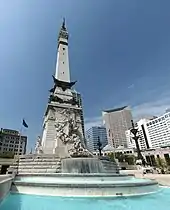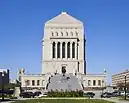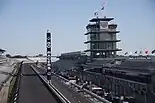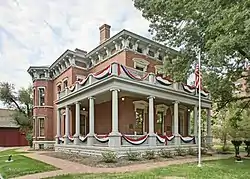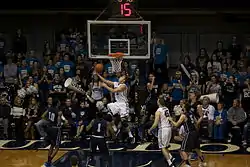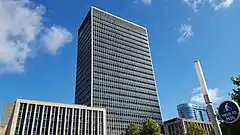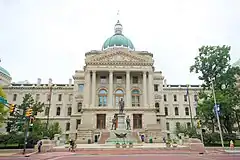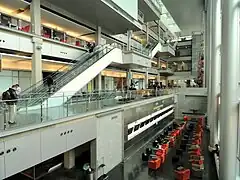Indianapolis
Indianapolis (/ˌɪndiəˈnæpəlɪs/ IN-dee-ə-NAP-ə-lis),[9][10] colloquially known as Indy, is the capital and most populous city of the U.S. state of Indiana and the seat of Marion County. Located in Central Indiana, the city lies along the White River's West Fork near its confluence with Fall Creek.
Indianapolis | |
|---|---|
 Seal | |
| Nicknames: "Indy", "Circle City", "Crossroads of America", "Naptown", "Racing Capital of the World", "Amateur Sports Capital of the World", "Railroad City"[1] | |
_Highlighted_1836003.svg.png.webp) Location within Marion County | |
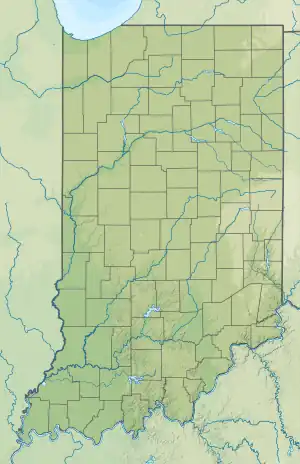 Indianapolis Location within Indiana  Indianapolis Location within the United States 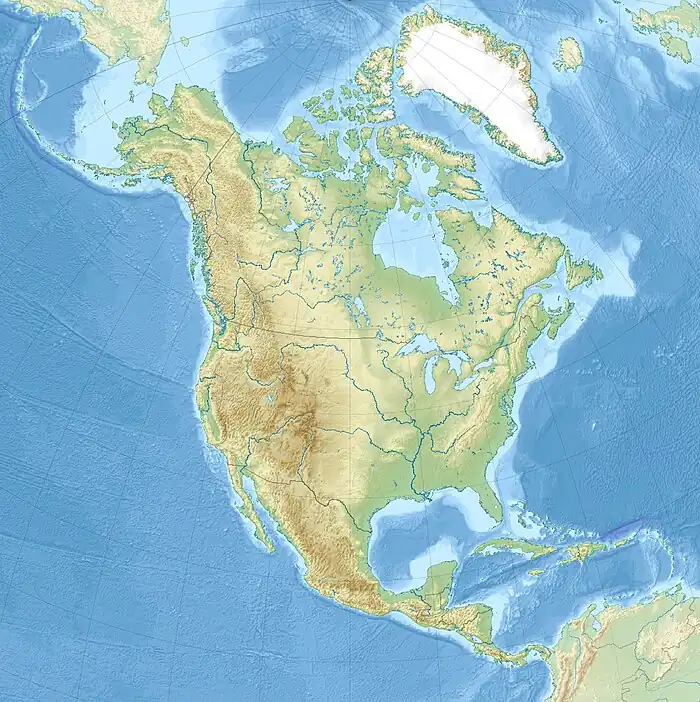 Indianapolis Location within North America | |
| Coordinates: 39°46′07″N 86°09′29″W | |
| Country | United States |
| State | Indiana |
| County | Marion |
| Townships | |
| Founded | January 6, 1821[2] |
| Incorporated (town) | September 3, 1831[2] |
| Incorporated (city) | March 30, 1847[2] |
| City-county consolidation | January 1, 1970[3] |
| Government | |
| • Type | Strong mayor–council |
| • Body | Indianapolis City-County Council |
| • Mayor | Joe Hogsett (D) |
| Area | |
| • State capital and consolidated city-county | 367.93 sq mi (952.95 km2) |
| • Land | 361.64 sq mi (936.64 km2) |
| • Water | 6.29 sq mi (16.30 km2) |
| Elevation | 718 ft (219 m) |
| Population (2020) | |
| • State capital and consolidated city-county | 887,642 |
| • Rank | 42nd in North America 16th in the United States 1st in Indiana |
| • Density | 2,454.50/sq mi (947.69/km2) |
| • Urban | 1,699,881 (US: 32nd) |
| • Urban density | 2,352.6/sq mi (908.4/km2) |
| • Metro | 2,111,040 (US: 34th) |
| Demonym | Indianapolitan[7] |
| Time zone | UTC−5 (EST) |
| • Summer (DST) | UTC−4 (EDT) |
| ZIP Codes | 61 total ZIP codes:
|
| Area codes | 317 and 463 |
| FIPS code | 18-36003[8] |
| GNIS feature ID | 2395423[5] |
| Website | indy |
At the 2020 census, the balance population was 887,642.[11] Indianapolis is the 16th-most populous city in the U.S., the third-most populous city in the Midwest after Chicago and Columbus, Ohio, and the fourth-most populous state capital after Phoenix, Arizona, Austin, Texas, and Columbus. The Indianapolis metropolitan area is the 34th-most populous metropolitan statistical area in the U.S., home to 2.1 million residents.[12] With a population of more than 2.5 million, the combined statistical area ranks 27th.[13] Indianapolis proper covers 368 square miles (950 km2), making it the 18th-most extensive city by land area in the country.
Indigenous peoples inhabited the area dating to as early as 10,000 BC.[14] In 1818, the Lenape relinquished their tribal lands in the Treaty of St. Mary's.[15] In 1821, Indianapolis was founded as a planned city for the new seat of Indiana's state government. The city was platted by Alexander Ralston and Elias Pym Fordham on a 1-square-mile (2.6 km2) grid. Completion of the National and Michigan roads and the arrival of rail later solidified the city's position as a manufacturing and transportation hub.[16] Two of the city's nicknames, the "Crossroads of America" and "Railroad City", reflect the city's historical ties to transportation.[17][18][1] Since the 1970 city-county consolidation, known as Unigov, local government administration operates under the direction of an elected 25-member city-county council headed by the mayor.
Indianapolis anchors the 30th largest metropolitan economy in the U.S.,[19] based primarily on the industries of trade, transportation, and utilities; professional and business services; education and health services; government; leisure and hospitality; and manufacturing.[20] The city has notable niche markets in amateur sports and auto racing.[21][22] The city is home to three Fortune 500 companies, two major league sports teams, the Indianapolis Colts of the National Football League and the Indiana Pacers of the National Basketball Association, five university campuses, and several museums, including the world's largest children's museum.[23][24] The city is perhaps best known for annually hosting the world's largest single-day sporting event, the Indianapolis 500.[25][26] Among the city's historic sites and districts, Indianapolis is home to the largest collection of monuments dedicated to veterans and war casualties in the U.S. outside of Washington, D.C.[27][28]
Etymology
The name Indianapolis is derived from pairing the state's name, Indiana (meaning "Land of the Indians", or simply "Indian Land"[29]), with the suffix -polis, the Greek word for "city". Jeremiah Sullivan, justice of the Indiana Supreme Court, is credited with coining the name.[30] Other names considered were Concord, Suwarrow, and Tecumseh.[31]
History
Founding
_(14803447463).jpg.webp)
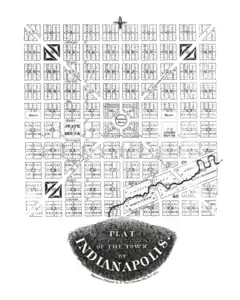
In 1816, the year Indiana gained statehood, the U.S. Congress donated four sections of federal land to establish a permanent seat of state government.[32] Two years later, under the Treaty of St. Mary's (1818), the Delaware relinquished title to their tribal lands in central Indiana, agreeing to leave the area by 1821.[15] This tract of land, which was called the New Purchase, included the site selected for the new state capital in 1820.[33] The indigenous people of the land prior to systematic removal are the Miami Nation of Indiana (Miami Nation of Oklahoma) and Indianapolis makes up part of Cession 99; the primary treaty between the indigenous population and the United States was the Treaty of St. Mary's (1818).[34]
The availability of new federal lands for purchase in central Indiana attracted settlers, many of them descendants of families from northwestern Europe. Although many of these first European and American settlers were Protestants, a large proportion of the early Irish and German immigrants were Catholics. Few African Americans lived in central Indiana before 1840.[35] The first European Americans to permanently settle in the area that became Indianapolis were either the McCormick or Pogue families. The McCormicks are generally considered to be the first permanent settlers; however, some historians believe George Pogue and family may have arrived first, on March 2, 1819, and settled in a log cabin along the creek that was later called Pogue's Run. Other historians have argued as early as 1822 that John Wesley McCormick and his family and employees became the area's first European American settlers, settling near the White River in February 1820.[36]
On January 11, 1820, the Indiana General Assembly authorized a committee to select a site in central Indiana for the new state capital.[37] The state legislature approved the site, adopting the name Indianapolis on January 6, 1821.[2] In April, Alexander Ralston and Elias Pym Fordham were appointed to survey and design a town plan for the new settlement.[38] Indianapolis became a seat of county government on December 31, 1821, when Marion County, was established. A combined county and town government continued until 1832 when Indianapolis was incorporated as a town. Indianapolis became an incorporated city effective March 30, 1847. Samuel Henderson, the city's first mayor, led the new city government, which included a seven-member city council. In 1853, voters approved a new city charter that provided for an elected mayor and a fourteen-member city council. The city charter continued to be revised as Indianapolis expanded.[39] Effective January 1, 1825, the seat of state government moved to Indianapolis from Corydon, Indiana. In addition to state government offices, a U.S. district court was established at Indianapolis in 1825.[40]
Growth occurred with the opening of the National Road through the town in 1827, the first major federally funded highway in the United States.[41] A small segment of the ultimately failed Indiana Central Canal was opened in 1839.[42] The first railroad to serve Indianapolis, the Jeffersonville, Madison and Indianapolis Railroad, began operation in 1847, and subsequent railroad connections fostered growth.[43] Indianapolis Union Station was the first of its kind in the world when it opened in 1853.[44]
Civil War and Gilded Age
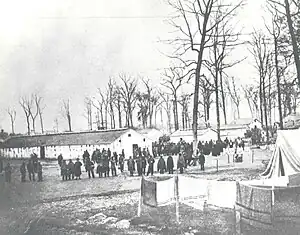
During the American Civil War, Indianapolis was mostly loyal to the Union cause. Governor Oliver P. Morton, a major supporter of President Abraham Lincoln, quickly made Indianapolis a rallying place for Union army troops. On February 11, 1861, President-elect Lincoln arrived in the city, en route to Washington, D.C. for his presidential inauguration, marking the first visit from a president-elect in the city's history.[45] On April 16, 1861, the first orders were issued to form Indiana's first regiments and establish Indianapolis as a headquarters for the state's volunteer soldiers.[46][47] Within a week, more than 12,000 recruits signed up to fight for the Union.[48]
Indianapolis became a major logistics hub during the war, establishing the city as a crucial military base.[49][50] Between 1860 and 1870, the city's population more than doubled.[43] An estimated 4,000 men from Indianapolis served in 39 regiments, and an estimated 700 died during the war.[51] On May 20, 1863, Union soldiers attempted to disrupt a statewide Democratic convention at Indianapolis, forcing an adjournment of the proceedings, sarcastically referred to as the Battle of Pogue's Run.[52] Fear turned to panic in July 1863, during Morgan's Raid into southern Indiana, but Confederate forces turned east toward Ohio, never reaching Indianapolis.[53] On April 30, 1865, Lincoln's funeral train made a stop at Indianapolis, where an estimated crowd of more than 100,000 people passed the assassinated president's bier at the Indiana Statehouse.[50][54]
Following the Civil War—and in the wake of the Second Industrial Revolution—Indianapolis experienced tremendous growth and prosperity. In 1880, Indianapolis was the world's third-largest pork packing city, after Chicago and Cincinnati, and the second-largest railroad center in the U.S. by 1888.[55][56] By 1890, the city's population surpassed 100,000.[43] Some of the city's most notable businesses were founded during this period of growth and innovation, including L. S. Ayres (1872), Eli Lilly and Company (1876), Madam C. J. Walker Manufacturing Company (1910), and Allison Transmission (1915).
20th century
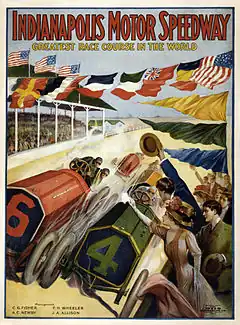
Some of the city's most prominent architectural features and best-known historical events date from the turn of the 20th century. The Soldiers' and Sailors' Monument, dedicated on May 15, 1902, would later become the city's unofficial symbol.[57] Ray Harroun won the inaugural running of the Indianapolis 500, held May 30, 1911, at Indianapolis Motor Speedway. Indianapolis was one of the hardest hit cities in the Great Flood of 1913, resulting in five known deaths[58][59][60] and the displacement of 7,000 families.[61]
Once home to 60 automakers, Indianapolis rivaled Detroit as a center of automobile manufacturing.[62] The city was an early focus of labor organization.[43] The Indianapolis streetcar strike of 1913 and subsequent police mutiny and riots led to the creation of the state's earliest labor-protection laws, including a minimum wage, regular work weeks, and improved working conditions.[63] The International Typographical Union and United Mine Workers of America were among several influential labor unions based in the city.[43]
As a stop on the Underground Railroad, Indianapolis had one of the largest black populations in the Northern States, until the Great Migration.[64] Led by D. C. Stephenson, the Indiana Klan became the most powerful political and social organization in Indianapolis from 1921 through 1928, controlling the City Council and the Board of School Commissioners, among others. At its height, more than 40% of native-born white males in Indianapolis claimed membership in the Klan.
While campaigning in the city in 1968, Robert F. Kennedy delivered one of the most lauded speeches in 20th century American history, following the assassination of civil rights leader Martin Luther King Jr.[65][66][67] As in most U.S. cities during the Civil Rights Movement, the city experienced strained race relations. A 1971 federal court decision forcing Indianapolis Public Schools to implement desegregation busing proved controversial.[68]
During the mayoral administration of Richard Lugar (1968–1976), the city and county governments consolidated. Known as Unigov (a portmanteau of "unified" and "government"), the city-county consolidation removed bureaucratic redundancies, captured increasingly suburbanizing tax revenue, and created a Republican political machine that dominated local politics until the early 2000s.[69][70] Effective January 1, 1970, Unigov expanded the city's land area by more than 300 square miles (780 km2) and increased its population by some 250,000 people.[71] It was the first major city-county consolidation to occur in the U.S. without a referendum since the creation of the City of Greater New York in 1898.[72] Lugar is credited with initiating downtown revitalization, overseeing the building of Market Square Arena, Indianapolis City Market renovations, and formation of Indiana University–Purdue University Indianapolis.[73]
Amid the changes in government and growth, the city pursued an aggressive economic development strategy to raise the city's stature as a sports tourism destination, known as the Indianapolis Project.[74] During the administration of the city's longest-serving mayor, William Hudnut (1976–1992), millions of dollars were invested into sports venues and public relations campaigns. The strategy was successful in landing the U.S. Olympic Festival in 1982, securing the relocation of the Baltimore Colts in 1984, and hosting the 1987 Pan American Games.[22]
Beginning in 1992, the mayoral administration of Stephen Goldsmith introduced a number of austerity measures to address budget shortfalls through privatization and greater reliance on public–private partnerships. Major downtown revitalization projects continued through the 1990s, including the openings of Circle Centre Mall, Victory Field, and Gainbridge Fieldhouse, as well as ongoing redevelopment of the Indiana Central Canal and White River State Park areas.[75]
21st century
Bart Peterson took office in 2000, the first Democrat elected to the post since John J. Barton's 1963 election.[76] The Peterson administration focused on education reform and promoting the arts. In 2001, the mayor's office became the first in the U.S. to authorize charter schools. Indianapolis Cultural Districts were designated in 2003, followed by the groundbreaking of the Indianapolis Cultural Trail in 2007. Further consolidation of city and county units of government resulted in the establishment of the Indianapolis Metropolitan Police Department in 2007. Later that year, Greg Ballard succeeded Peterson in a political upset.[77]
The Ballard administration oversaw the lease of the city's parking meters and the sale of the city's water and wastewater utilities with proceeds financing street repairs. Ballard pursued several environmental sustainability efforts, including establishing an office of sustainability, installing 200 miles (320 km) of bike lanes and trails, and spearheading a controversial deal to start an electric carsharing program.[78][79] Two of the city's largest capital projects, the Indianapolis International Airport's new terminal and Lucas Oil Stadium, were completed in 2008.[80][81] In 2012, construction began on a $2 billion tunnel system designed to reduce sewage overflows into the city's waterways.[82]
Since 2016, the administration of Joe Hogsett has focused on addressing a rise in gun violence and the city's racial disparities. In recent years, significant capital and operational investments have been made in public safety, criminal justice, and public transit. The city also established rental assistance and food security programs. In 2020, the George Floyd protests in Indiana prompted a series of local police reforms and renewed efforts to bolster social services for mental health treatment and homelessness.[83][84] In 2021, a mass shooting occurred at a FedEx facility on the city's southwest side, killing nine including the gunman and injuring seven others.[85][86]
Geography

Indianapolis is located in the East North Central region of the Midwestern United States, about 14 miles (23 km) south-southeast of Indiana's geographic center.[87] According to the U.S. Census Bureau, the Indianapolis (balance) encompasses a total area of 367.9 square miles (953 km2), of which 361.6 square miles (937 km2) is land and 6.3 square miles (16 km2) is water.[4] It is the 18th-most extensive city by land area in the U.S.
As a consolidated city-county, the city's municipal boundaries are coterminous with Marion County, except the autonomous and semi-autonomous municipalities outlined in Unigov.[43][88] Nine civil townships form the broadest geographic divisions within the city and county.[89] The consolidated city-county borders the adjacent counties of Boone to the northwest; Hamilton to the north; Hancock to the east; Shelby to the southeast; Johnson to the south; Morgan to the southwest; and Hendricks to the west.[90]
Topography
Indianapolis is located within a physiographic province known as the Tipton Till Plain, a flat, gently rolling terrain underlain by glacial deposits known as till. The lowest point in the city is about 650 feet (198 m) above mean sea level, with the highest natural elevation at about 900 feet (274 m) above sea level.[91] Few hills or short ridges, known as kames, rise about 100 feet (30 m) to 130 feet (40 m) above the surrounding terrain. The city lies just north of the Indiana Uplands, a region characterized by rolling hills and high limestone content.
Indianapolis is located in the West Fork White River drainage basin, part of the larger Mississippi River watershed[92] via the Wabash and Ohio rivers.[90] The White River is fed by some 35 tributaries, including Fall Creek and Pogue's Run, as it flows 31 miles (50 km) north-to-south through the city.[93] The city's largest water bodies are artificial quarry lakes or reservoirs.
Cityscape
.jpg.webp)
Indianapolis is a planned city. On January 11, 1820, the Indiana General Assembly authorized a committee to select a site in central Indiana for the new state capital, appointing Alexander Ralston and Elias Pym Fordham to survey and design a town plan for Indianapolis. Ralston had been a surveyor for the French architect Pierre L'Enfant, assisting him with the plan for Washington, D.C. Ralston's original plan for Indianapolis called for a town of 1 square mile (2.6 km2), near the confluence of the White River and Fall Creek.[94]
The plan, known as the Mile Square, is bounded by East, West, North, and South streets, centered on a traffic circle, called Monument Circle (originally Circle Street), from which Indianapolis's "Circle City" nickname originated.[95] Four diagonal streets radiated a block from Monument Circle: Massachusetts, Virginia, Kentucky, and Indiana avenues.[96] The city's address numbering system begins at the intersection of Washington and Meridian streets.[97] Before its submersion into a sanitary tunnel, Pogue's Run was included into the plan, disrupting the rectilinear street grid to the southeast.
Compared to American cities of similar populations, Indianapolis is unique in that it contains some 200 farms covering thousands of acres of agricultural land within its municipal boundaries.[98] Equestrian farms and corn and soybean fields interspersed with suburban development are commonplace on the city's periphery, especially in Franklin Township.[99]
Architecture

Noted as one of the finest examples of the City Beautiful movement design in the U.S., the Indiana World War Memorial Plaza Historic District began construction in 1921 in downtown Indianapolis.[100][101] The district, a National Historic Landmark, encompasses several examples of neoclassical architecture, including the American Legion, Central Library, and Birch Bayh Federal Building and United States Courthouse. The district is also home to several sculptures and memorials, Depew Memorial Fountain, and open space, hosting many annual civic events.[101]
After completion of the Soldiers' and Sailors' Monument, an ordinance was passed in 1905 restricting building heights on the traffic circle to 86 ft (26 m) to protect views of the 284 ft (87 m) monument.[102] The ordinance was revised in 1922, permitting buildings to rise to 108 ft (33 m), with an additional 42 ft (13 m) allowable with a series of setbacks.[102] A citywide height restriction ordinance was instituted in 1912, barring structures over 200 ft (61 m).[103] Completed in 1962, the City-County Building was the first high-rise in the city to surpass the Soldiers' and Sailors' Monument in height.[104] A building boom, lasting from 1982 to 1990, saw the construction of six of the city's ten tallest buildings.[105][106] The tallest is Salesforce Tower, completed in 1990 at 811 ft (247 m).[107]
Indiana limestone is the signature building material in Indianapolis, widely included in the city's many monuments, churches, academic, government, and civic buildings.[105]
Neighborhoods
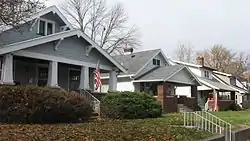
For statistical purposes, the consolidated city-county is organized into 99 "neighborhood areas" with most containing numerous individual historic and cultural districts, subdivisions, and some semi-autonomous towns. In total, some 500 self-identified neighborhood associations are listed in the city's Registered Community Organization system.[108] As a result of the city's expansive land area, Indianapolis has a unique urban-to-rural transect, ranging from dense urban neighborhoods to suburban tract housing subdivisions, to rural villages.[109]
Typical of American cities in the Midwest, Indianapolis urbanized in the late 19th and early 20th centuries, resulting in the development of relatively dense, well-defined neighborhoods clustered around streetcar corridors, especially in Center Township.[110] Notable streetcar suburbs include Broad Ripple, Irvington, and University Heights.[111] Starting in the mid-20th century, the post–World War II economic expansion and subsequent suburbanization greatly influenced the city's development patterns. From 1950 to 1970, nearly 100,000 housing units were built in Marion County, most outside Center Township in suburban neighborhoods such as Castleton, Eagledale, and Nora.[111]
Since the 2000s, downtown Indianapolis and surrounding neighborhoods have seen increased reinvestment mirroring nationwide market trends, driven by empty nesters and millennials.[112][113] Renewed interest in urban living has been met with some dispute regarding gentrification and affordable housing.[114][115][116] According to a Center for Community Progress report, neighborhoods like Cottage Home and Fall Creek Place have experienced measurable gentrification since 2000.[117] The North Meridian Street Historic District is among the most affluent urban neighborhoods in the U.S., with a mean household income of $102,599 in 2017.[118]
Parks
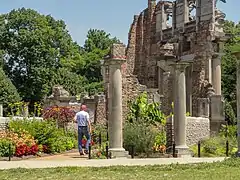
Indianapolis maintains 212 public parks covering 11,258 acres (4,556 ha) of green space, representing about 5.1% of the city's land area.[119][120] Amenities include 129 playgrounds, 155 sports fields, 153 miles (246 km) of recreational trails, 23 recreation and nature centers, 21 spraygrounds, 19 aquatic centers, 13 golf courses, and four dog parks.[119] The department also provides 2,400 programs and classes annually.[121] Eagle Creek Park is the largest and most visited park in the city and ranks among the largest municipal parks in the U.S., covering 4,766 acres (1,929 ha).[122]
Military Park was established as the city's first state-owned park in 1852. Garfield Park was the city's first municipally-owned park, opening in 1876 as Southern Park.[123][124] In the early 20th century, the city enlisted landscape architect George Kessler to conceive a framework for Indianapolis's modern parks system.[125] Kessler's 1909 Indianapolis Park and Boulevard Plan linked notable parks, such as Brookside, Ellenberger, Garfield, and Riverside, with a system of parkways following the city's waterways.[126] The system's 3,474 acres (1,406 ha) were added to the National Register of Historic Places in 2003.[127]
Marion County is home to two Indiana state parks: Fort Harrison State Park in Lawrence and White River State Park in downtown Indianapolis. Established in 1996, Fort Harrison State Park covers 1,744 acres (706 ha) under the management of the Indiana Department of Natural Resources.[128] White River is owned and operated by the White River State Park Development Commission, a quasi-governmental agency.[129] White River's 250 acres (100 ha) are home to several attractions, including the Indianapolis Zoo and White River Gardens. Two land trusts are active in the city managing several sites for nature conservation throughout the region.[130][131]
Flora and fauna
.jpg.webp)
Indianapolis is situated in the Southern Great Lakes forests ecoregion which in turn is located within the larger temperate broadleaf and mixed forests biome, as defined by the World Wide Fund for Nature.[132] Based on the U.S. Environmental Protection Agency's alternative classification system, the city is located in the Eastern Corn Belt Plains, an area of the country known for its fertile soil.[133]
Much of the decidious forests that once covered 98% of the region were cleared for agriculture and urban development, contributing to considerable habitat loss.[132][92] Indianapolis's current urban tree canopy averages approximately 33%.[134] A rare example of old-growth forest in the city can be found on 15 acres (6.1 ha) of Crown Hill Cemetery's North Woods in the Butler–Tarkington neighborhood.[135] The cemetery's 555 acres (225 ha) represents the largest green space in Center Township, home to an abundance of wildlife and some 130 species of trees.[136] Native trees most common to the area include varieties of ash, maple, and oak.[132] Several invasive species are also common in Indianapolis, including tree of heaven, wintercreeper, Amur honeysuckle, and Callery pear.[137][138]
A 2016 bioblitz along three of the city's riparian corridors found 590 taxa.[92] Urban wildlife common to the Indianapolis area include mammals such as the white-tailed deer, eastern chipmunk, eastern cottontail, and the eastern grey and American red squirrels.[132] In recent years, local raccoon and groundhog populations have increased alongside sightings of American badgers, beavers, mink, coyotes, and red fox.[139][140] Birds native to the area include the northern cardinal, wood thrush, eastern screech owl, mourning dove, pileated and red-bellied woodpeckers, and wild turkey.[132] Located in the Mississippi Flyway, the city sees more than 400 migratory bird species throughout the year.[141][142][143] Some 57 species of fish can be found in the city's waterways, including bass and sunfish.[93] Some federally-designated endangered and threatened species are native to the Indianapolis area, including several species of freshwater mussels, the rusty patched bumble bee, Indiana bat, northern long-eared bat, and the running buffalo clover.[144]
In recent years, the National Wildlife Federation has ranked Indianapolis among the ten most wildlife-friendly cities in the U.S.[145]
Climate
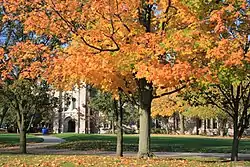

Indianapolis has a hot-summer humid continental climate (Köppen climate classification Dfa), but can be considered a borderline humid subtropical climate (Köppen: Cfa) using the −3 °C (27 °F) isotherm. It experiences four distinct seasons.[146] The city lies at the transition between USDA plant hardiness zones 5b and 6a.[147]
Typically, summers are fairly hot, humid, and wet. Winters are generally cold with moderate snowfall. The July daily average temperature is 75.4 °F (24.1 °C). High temperatures reach or exceed 90 °F (32 °C) an average of 18 days each year,[148] and occasionally exceed 95 °F (35 °C). Spring and autumn are usually pleasant, if at times unpredictable; midday temperature drops exceeding 30 °F or 17 °C are common during March and April, and instances of very warm days (80 °F or 27 °C) followed within 36 hours by snowfall are not unusual during these months. Winters are cold, with an average January temperature of 28.1 °F (−2.2 °C). Temperatures dip to 0 °F (−18 °C) or below an average of 3.7 nights per year.[148]
The rainiest months occur in the spring and summer, with slightly higher averages during May, June, and July. May is typically the wettest, with an average of 5.05 inches (12.8 cm) of precipitation.[148] Most rain is derived from thunderstorm activity; there is no distinct dry season, although occasional droughts occur. Severe weather is not uncommon, particularly in the spring and summer months; the city experiences an average of 20 thunderstorm days annually.[149]
The city's average annual precipitation is 42.4 inches (108 cm), with snowfall averaging 25.9 inches (66 cm) per season. Official temperature extremes range from 106 °F (41 °C), set on July 14, 1936,[150] to −27 °F (−33 °C), set on January 19, 1994.[150][151]
| Climate data for Indianapolis (Indianapolis International Airport), 1991–2020 normals,[lower-alpha 1] extremes 1871–present[lower-alpha 2] | |||||||||||||
|---|---|---|---|---|---|---|---|---|---|---|---|---|---|
| Month | Jan | Feb | Mar | Apr | May | Jun | Jul | Aug | Sep | Oct | Nov | Dec | Year |
| Record high °F (°C) | 71 (22) |
77 (25) |
85 (29) |
90 (32) |
96 (36) |
104 (40) |
106 (41) |
103 (39) |
100 (38) |
92 (33) |
81 (27) |
74 (23) |
106 (41) |
| Mean maximum °F (°C) | 58.8 (14.9) |
64.4 (18.0) |
74.0 (23.3) |
80.8 (27.1) |
87.1 (30.6) |
91.9 (33.3) |
93.4 (34.1) |
92.6 (33.7) |
90.7 (32.6) |
82.8 (28.2) |
70.5 (21.4) |
61.7 (16.5) |
94.9 (34.9) |
| Average high °F (°C) | 36.1 (2.3) |
40.8 (4.9) |
51.9 (11.1) |
63.9 (17.7) |
73.4 (23.0) |
82.0 (27.8) |
85.2 (29.6) |
84.3 (29.1) |
78.2 (25.7) |
65.6 (18.7) |
51.8 (11.0) |
40.4 (4.7) |
62.8 (17.1) |
| Daily mean °F (°C) | 28.5 (−1.9) |
32.5 (0.3) |
42.4 (5.8) |
53.6 (12.0) |
63.6 (17.6) |
72.5 (22.5) |
75.8 (24.3) |
74.7 (23.7) |
67.8 (19.9) |
55.5 (13.1) |
43.3 (6.3) |
33.3 (0.7) |
53.6 (12.0) |
| Average low °F (°C) | 20.9 (−6.2) |
24.2 (−4.3) |
33.0 (0.6) |
43.3 (6.3) |
53.7 (12.1) |
62.9 (17.2) |
66.4 (19.1) |
65.0 (18.3) |
57.4 (14.1) |
45.5 (7.5) |
34.9 (1.6) |
26.2 (−3.2) |
44.4 (6.9) |
| Mean minimum °F (°C) | −2.1 (−18.9) |
4.8 (−15.1) |
14.9 (−9.5) |
27.2 (−2.7) |
37.8 (3.2) |
49.2 (9.6) |
56.1 (13.4) |
55.1 (12.8) |
43.1 (6.2) |
30.2 (−1.0) |
19.6 (−6.9) |
6.8 (−14.0) |
−4.9 (−20.5) |
| Record low °F (°C) | −27 (−33) |
−21 (−29) |
−7 (−22) |
18 (−8) |
27 (−3) |
37 (3) |
46 (8) |
41 (5) |
30 (−1) |
20 (−7) |
−5 (−21) |
−23 (−31) |
−27 (−33) |
| Average precipitation inches (mm) | 3.12 (79) |
2.43 (62) |
3.69 (94) |
4.34 (110) |
4.75 (121) |
4.95 (126) |
4.42 (112) |
3.20 (81) |
3.14 (80) |
3.22 (82) |
3.45 (88) |
2.92 (74) |
43.63 (1,108) |
| Average snowfall inches (cm) | 8.8 (22) |
6.0 (15) |
3.2 (8.1) |
0.2 (0.51) |
0.0 (0.0) |
0.0 (0.0) |
0.0 (0.0) |
0.0 (0.0) |
0.0 (0.0) |
0.1 (0.25) |
0.8 (2.0) |
6.4 (16) |
25.5 (65) |
| Average precipitation days (≥ 0.01 in) | 12.3 | 10.3 | 11.5 | 11.9 | 13.3 | 11.5 | 10.3 | 8.3 | 7.9 | 8.9 | 10.2 | 11.8 | 128.2 |
| Average snowy days (≥ 0.1 in) | 7.0 | 5.8 | 2.4 | 0.3 | 0.0 | 0.0 | 0.0 | 0.0 | 0.0 | 0.1 | 1.2 | 5.6 | 22.4 |
| Average relative humidity (%) | 75.0 | 73.6 | 69.9 | 65.6 | 67.1 | 68.4 | 72.8 | 75.4 | 74.4 | 71.6 | 75.5 | 78.0 | 72.3 |
| Average dew point °F (°C) | 18.1 (−7.7) |
21.6 (−5.8) |
30.9 (−0.6) |
39.7 (4.3) |
50.5 (10.3) |
59.9 (15.5) |
64.9 (18.3) |
63.7 (17.6) |
56.7 (13.7) |
44.1 (6.7) |
34.9 (1.6) |
24.4 (−4.2) |
42.4 (5.8) |
| Mean monthly sunshine hours | 132.1 | 145.7 | 178.3 | 214.8 | 264.7 | 287.2 | 295.2 | 273.7 | 232.6 | 196.6 | 117.1 | 102.4 | 2,440.4 |
| Percent possible sunshine | 44 | 49 | 48 | 54 | 59 | 64 | 65 | 64 | 62 | 57 | 39 | 35 | 55 |
| Average ultraviolet index | 2 | 3 | 4 | 6 | 8 | 9 | 9 | 8 | 6 | 4 | 2 | 2 | 5 |
| Source 1: NOAA (relative humidity, dew point, and sun 1961–1990[148][152][153] | |||||||||||||
| Source 2: Weather Atlas (UV)[154] | |||||||||||||
Demographics
| Census | Pop. | Note | %± |
|---|---|---|---|
| 1840 | 2,695 | — | |
| 1850 | 8,091 | 200.2% | |
| 1860 | 18,611 | 130.0% | |
| 1870 | 48,244 | 159.2% | |
| 1880 | 75,056 | 55.6% | |
| 1890 | 105,436 | 40.5% | |
| 1900 | 169,164 | 60.4% | |
| 1910 | 233,650 | 38.1% | |
| 1920 | 314,194 | 34.5% | |
| 1930 | 364,161 | 15.9% | |
| 1940 | 386,972 | 6.3% | |
| 1950 | 427,173 | 10.4% | |
| 1960 | 476,258 | 11.5% | |
| 1970 | 744,624 | 56.3% | |
| 1980 | 700,807 | −5.9% | |
| 1990 | 731,327 | 4.4% | |
| 2000 | 781,926 | 6.9% | |
| 2010 | 820,445 | 4.9% | |
| 2020 | 887,642 | 8.2% | |
| 2022 (est.) | 880,621 | −0.8% | |
| U.S. Decennial Census[155] | |||
The U.S. Census Bureau considers Indianapolis as two entities: the consolidated city and the city's remainder, or balance. The consolidated city is coterminous with Marion County, except the independent municipalities of Beech Grove, Lawrence, Southport, and Speedway.[156] The city's balance excludes the populations of ten semi-autonomous municipalities that are included in totals for the consolidated city.[88] These are Clermont, Crows Nest, Homecroft, Meridian Hills, North Crows Nest, Rocky Ripple, Spring Hill, Warren Park, Williams Creek, and Wynnedale.[156][3] An eleventh town, Cumberland, is partially included.[157][158]
In 2015, Brookings characterized the Indianapolis metropolitan area as a minor-emerging immigrant gateway with a foreign-born population of 126,767, or 6.4% of the total population, a 131% increase from 2000.[159] Much of this growth can be attributed to thousands of Burmese-Chin refugees who have settled in Indianapolis, particularly Perry Township, since the late 1990s.[160] Indianapolis is home to one of the largest concentrations of Chin people outside of Myanmar (formerly Burma), with an estimated population ranging from 17,000 to 24,000.[161][162][163]
The Williams Institute reported that the Indianapolis metropolitan area had an estimated 4.6% LGBT adult population in 2020, totaling about 68,000.[164]
Census and estimates
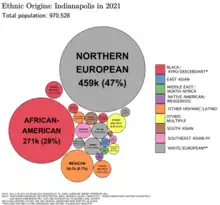
.png.webp)
| Racial composition | 2020[165] | 2010[166] | 1990[167] | 1970[167] |
|---|---|---|---|---|
| White (Non-Hispanic) | 50.1% | 58.6% | 75.2% | 80.9% |
| Black or African American | 27.6% | 27.2% | 22.6% | 18.0% |
| Hispanic or Latino | 13.1% | 9.4% | 1.1% | 0.8% |
| Asian | 4.2% | 2.1% | 0.9% | 0.1% |
| Mixed | 4.2% | 2.2% | – | – |
At the 2020 census, Indianapolis had a population of 887,642 and a population density of 2,455 people per square mile (948/km2). The estimated population was 880,621 in 2022.[11] By population, Indianapolis is the state's largest city and the country's 16th largest.[168]
The Indianapolis metropolitan area, officially the Indianapolis–Carmel–Greenwood, IN metropolitan statistical area (MSA), consists of Marion County and the surrounding counties of Boone, Brown, Hamilton, Hancock, Hendricks, Johnson, Madison, Morgan, Shelby, and Tipton.[169] In 2020, the metropolitan area's population was 2,111,040, the most populous in Indiana and home to 31% of the state's residents. In 2022, the estimated population was 2,141,779.[12] In 2020, the larger Indianapolis–Carmel–Muncie, IN combined statistical area (CSA) had a population of 2,492,514, home to nearly 37% of Indiana residents across 20 of Indiana's 92 counties.[169] In 2022, the estimated population was 2,524,790.[13]
According to the U.S. Census of 2010, 97.2% of the Indianapolis population was reported as one race: 61.8% White, 27.5% Black or African American, 2.1% Asian (0.4% Burmese, 0.4% Indian, 0.3% Chinese, 0.3% Filipino, 0.1% Korean, 0.1% Vietnamese, 0.1% Japanese, 0.1% Thai, 0.1% other Asian); 0.3% American Indian, and 5.5% as other. The remaining 2.8% of the population was reported as multiracial (two or more races).[170] The city's Hispanic or Latino community constituted 9.4% of the city's population in the 2010 U.S. Census: 6.9% Mexican, 0.4% Puerto Rican, 0.1% Cuban, and 2% as other.[170]
In 2010, the median age for Indianapolis was 33.7 years. Age distribution for the city's inhabitants was 25% under the age of 18; 4.4% were between 18 and 21; 16.3% were age 21 to 65; and 13.1% were age 65 or older.[170] For every 100 females, there were 93 males. For every 100 females age 18 and over, there were 90 males.[171]
The 2010 census reported 332,199 households in Indianapolis, with an average household size of 2.42 and an average family size of 3.08.[170] Of the total households, 59.3% were family households, with 28.2% of these including the family's own children under the age of 18; 36.5% were husband-wife families; 17.2% had a female householder (with no husband present) and 5.6% had a male householder (with no wife present). The remaining 40.7% were non-family households.[170] As of 2010, 32% of the non-family households included individuals living alone, 8.3% of these households included individuals age 65 years of age or older.[170]
The U.S. Census Bureau's 2007–2011 American Community Survey indicated the median household income for Indianapolis city was $42,704, and the median family income was $53,161.[172] Median income for males working full-time, year-round, was $42,101, compared to $34,788 for females. Per capita income for the city was $24,430, 14.7% of families and 18.9% of the city's total population living below the poverty line (28.3% were under the age of 18 and 9.2% were age 65 or older).[172]
Religion
Of the 42.42% of the city's residents who identify as religious, Roman Catholics make up the largest group, at 11.31%.[173] The second highest religious group in the city are Baptists at 10.31%, with Methodists following behind at 4.97%. Presbyterians make up 2.13% of the city's religiously affiliated population, followed by Pentecostals and Lutherans. Another 8.57% are affiliated with other Christian faiths.[173] 0.32% of religiously affiliated persons identified themselves as following Eastern religions, while 0.68% of the religiously affiliated population identified as Jewish, and 0.29% as Muslim.[173] According to the nonpartisan and nonprofit Public Religion Research Institute's American Values Atlas, 22% of residents identify as religiously "unaffiliated", consistent with the national average of 22.7%.[174]
SS. Peter and Paul Cathedral is the seat of the Roman Catholic Archdiocese of Indianapolis.[175] Bishop Simon Bruté College Seminary and Marian University are affiliated with the archdiocese. Christian Theological Seminary is another seminary located in the city, affiliated with the Christian Church (Disciples of Christ). Christ Church Cathedral, the city's oldest house of worship, is pro-cathedral of the Episcopal Diocese of Indianapolis.[176] The Indiana-Kentucky Synod of the Evangelical Lutheran Church in America is also based in Indianapolis. Religious denominations headquartered in the city include the Free Methodist Church[177] and Lutheran Ministerium and Synod – USA.
Economy
According to the U.S. Bureau of Labor Statistics, the largest industries by employment in the Indianapolis metropolitan area are trade, transportation, and utilities; professional and business services; education and health services; government; leisure and hospitality; and manufacturing, respectively. The region's unemployment rate was 1.2 percent in December 2021.[20]
Indianapolis anchors the 30th largest metropolitan economy in the U.S., with a gross domestic product of (USD) $162.1 billion in 2021.[19] The city's major exports include pharmaceuticals, motor vehicle parts, medical equipment and supplies, engine and power equipment, and aircraft products and parts.[17]
Three Fortune 500 companies are based in the city: health insurance company Elevance Health;[178] pharmaceutical company Eli Lilly and Company;[179] and agricultural chemical company Corteva.[180][181] Other companies based in the city include Allison Transmission, Barnes & Thornburg, Calumet Specialty Products Partners, Emmis Communications, Finish Line, Inc., Herff Jones, Klipsch Audio Technologies, Lids, OneAmerica Financial Partners, Inc., Republic Airways Holdings, Simon Property Group,[182] and Steak 'n Shake.
Distribution and logistics

Indianapolis's central location and extensive highway and rail infrastructure have positioned the city as an important logistics center. According to the Indy Chamber, the region was home to some 4,300 establishments employing nearly 110,000 in 2020.[183]
Amazon has a major presence in the Indianapolis metropolitan area, employing 9,000.[184] FedEx employs 7,000[185] workers across 35 facilities in the city, including FedEx Express's National Hub, which employs 5,800 workers in sorting, distribution, and shipping at Indianapolis International Airport.[186] Other logistics companies in the region with large workforces include Ingram Micro (1,300) and Venture Logistics (1,150).[185]
Life sciences and health
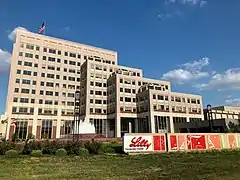
Indianapolis anchors one of the largest life sciences clusters in the U.S., notably in the subsectors of drugs and pharmaceuticals and agricultural feedstock and chemicals.[187][188] Life sciences employ between 21,200 and 28,700[189] among nearly 350 companies located in the region.[190] Pharmaceutical company Eli Lilly is the city's largest private employer, with a workforce of 11,000 in research and development, manufacturing, and executive administration.[191] Other major employers include Corteva (1,500),[180] Labcorp Drug Development (1,500),[192] and Roche's North American headquarters (4,500).[193][194][195]
Indianapolis is also a hub for academic medicine and health sciences research, home to such institutions as the Indiana Biosciences Research Institute, Indiana University School of Medicine, School of Nursing, and School of Dentistry; Marian University College of Osteopathic Medicine; and the American College of Sports Medicine. The regional healthcare providers of Community Health Network, Eskenazi Health, Franciscan Health, Indiana University Health, and St. Vincent Health have a combined workforce of 43,700.[196]
Manufacturing
Historically, manufacturing has been a critical component of Indianapolis's economic landscape; however, deindustrialization since the mid-20th century has significantly impacted the city's workforce. Indianapolis is typically considered part of the Rust Belt, a region of the Northeastern and Midwestern U.S. beleaguered by industrial and population decline.[197] Between 1990 and 2012, approximately 26,900 manufacturing jobs were lost in the city as it continued diversification efforts and transitioned to a service economy.[198] RCA and Western Electric formerly employed thousands at their Indianapolis manufacturing plants.[199][200]
Once home to 60 automakers, Indianapolis rivaled Detroit as a center of automobile manufacturing and design in the early 20th century.[62] Indianapolis was home to several luxury car companies, including Duesenberg, Marmon, and Stutz Motor Company; however, the automakers did not survive the Great Depression of the 1930s.[201] Detroit's Big Three automakers maintained a presence in the city and continued to operate in various capacities until the 2000s: Ford Motor Company (1914–1942, 1956–2008),[202] Chrysler (1925–2005), and General Motors (1930–2011).[201]
Indianapolis is home to Allison Transmission's headquarters and manufacturing facilities, employing 2,500 in the design and production of automatic transmissions and hybrid propulsion systems.[191] Rolls-Royce North America dates its local presence to the establishment of the Allison Engine Company in 1915. Its Indianapolis Operations Center has a workforce of 4,000 in aircraft engine development and manufacturing.[203][191] Other major manufacturing employers include Allegion (1,300) and Raytheon Technologies (1,000).[191] In 2016, Carrier Corporation announced the closure of its Indianapolis plant, moving 1,400 manufacturing jobs to Mexico.[204] Carrier later negotiated with the incoming Trump administration to save some jobs. The company's local workforce numbers 800 in gas furnace production.[205]
Hospitality
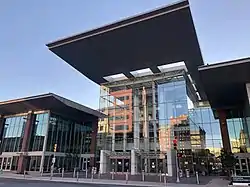
The hospitality industry is an increasingly vital sector of the Indianapolis economy. According to Visit Indy, 29.2 million visitors generate $5.6 billion annually, supporting 82,900 jobs.[206] Indianapolis has long been a sports tourism destination but has more recently relied on conventions.[207] From 2010 to 2019, average annual attendance for conventions was 494,000, an increase of 26% from the previous decade.[208]
The Indiana Convention Center (ICC) and Lucas Oil Stadium are considered mega convention center facilities, with a combined 750,000 square feet (70,000 m2) of exhibition space.[209] ICC is connected to 12 hotels and 4,700 hotel rooms, the most of any U.S. convention center.[210] Resident conventions annually hosted in the city include FDIC International, National FFA Organization Convention, Gen Con, and Performance Racing Industry (PRI) Trade Show.[208]
Technology
Indianapolis ranks among the fastest high-tech job growth areas in the U.S.[211][212] The metropolitan area is home to 28,500 information technology-related jobs at such companies as Angi, Formstack, Genesys, Hubstaff,[213] Infosys,[214] Ingram Micro, and Salesforce Marketing Cloud.[215][216] Salesforce has the largest workforce of local tech firms, employing about 2,100 in Indianapolis.[217]
Culture
Visual arts
.jpg.webp)
The city's primary art museum is the Indianapolis Museum of Art, founded in 1883 by suffragist May Wright Sewall. It is among the oldest and largest art museums in the U.S.[218] The museum's Newfields campus covers 152 acres (62 ha), home to the Virginia B. Fairbanks Art & Nature Park: 100 Acres; Oldfields, a restored house museum and National Historic Landmark; and restored gardens and grounds originally designed by Percival Gallagher of the Olmsted Brothers firm.[219] The museum's holdings demonstrate the institution's emphasis on the connections among art, design, and the natural environment.[220]
Established under the Works Progress Administration in 1934, the Indianapolis Art Center is a not-for-profit arts organization located in the city's Broad Ripple neighborhood. Its Michael Graves-designed building houses the Marilyn K. Glick School of Art, galleries, a library, and an auditorium. Sited along the White River, the center's 9.5 acres (3.8 ha) includes a public sculpture garden. The center hosts hundreds of classes, dozens of exhibitions, several outreach programs, and multiple art fairs and events throughout the year.[221]
Founded by local businessman and philanthropist Harrison Eiteljorg, the Eiteljorg Museum of American Indians and Western Art opened at White River State Park in 1989. In addition to its diverse collection of visual arts by indigenous peoples of the Americas and American Western art, the museum hosts numerous lectures, artist residencies, special exhibitions, and events annually.[222]
Located on the IUPUI campus, the Herron School of Art and Design was established in 1902 as the John Herron Art Institute. The school's first core faculty included Impressionist painters of the Hoosier Group: T. C. Steele, J. Ottis Adams, William Forsyth, Richard Gruelle, and Otto Stark.[223] The university's public art collection is extensive, with more than 30 works. Other public works can be found in the Eskenazi Health Art Collection and the Indiana Statehouse Public Art Collection.
Performing arts

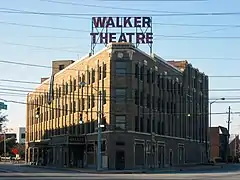
Several of the city's most prominent performing arts venues and organizations are located in the downtown area, including the Hilbert Circle Theatre[225] (home to the Indianapolis Symphony Orchestra)[226] and the Indiana Theatre (home to the Indiana Repertory Theatre).[227] Other notable venues near the central business district include The Cabaret,[228] Indianapolis Artsgarden,[229] Phoenix Theatre,[230] Slippery Noodle Inn,[231] and TCU Amphitheater at White River State Park, the city's largest outdoor venue.[232]
The Mass Ave Cultural Arts District is home to Old National Centre at the Murat Shrine, the oldest stagehouse in Indianapolis, having opened in 1910.[233] The center features a 2,500-seat performing arts theatre, 2,000-seat concert hall, and 900-seat multi-functional room, hosting approximately 400 public and private events throughout the year.[234] Mass Ave is also home to the Athenæum, Basile, District, and Indy Eleven theaters, all of which host the annual Indianapolis Theatre Fringe Festival, or "IndyFringe".[235][236]
The Madam Walker Legacy Center opened in the heart of the city's African-American neighborhood on Indiana Avenue in 1927. The building's theater hosted vaudeville shows and anchored the Indiana Avenue jazz scene from the 1920s through the 1960s.[237] "The Avenue" produced greats such as David Baker, Slide Hampton, Freddie Hubbard, J. J. Johnson, James Spaulding, and the Montgomery Brothers (Buddy, Monk, and Wes).[238] Wes Montgomery is considered one of the most influential jazz guitarists of all time,[238][239] and is credited with popularizing the "Naptown Sound".[240]
Local performing arts organizations include the Indianapolis Baroque Orchestra,[241] Indianapolis Chamber Orchestra,[242] Indianapolis Men's Chorus,[243] Indianapolis Opera,[244] and Indianapolis Youth Orchestra. Other notable venues include Butler University's Clowes Memorial Hall[245] and Melody Inn in Butler–Tarkington, The Emerson Theater in Little Flower, and the Jazz Kitchen in Meridian–Kessler.[246] The city's Broad Ripple and Fountain Square neighborhoods are known for local live music, home to dozens of venues.[247][248]
Indianapolis is home to a variety of national professional musical organizations, including the American Pianists Association,[249] Bands of America, Drum Corps International, and the Percussive Arts Society.[250][251] Annual music festivals and competitions held in the city include the Drum Corps International World Class Championships, Indianapolis Early Music Festival,[252] and Indy Jazz Fest.[253] The quadrennial International Violin Competition of Indianapolis is considered among the most prestigious of its kind in the world.[254]
Literature
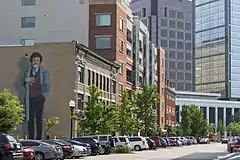
Founded in 1873, the Indianapolis Public Library consists of the Central Library and 24 branches throughout Marion County.[255] Central Library's special collections include the Center for Black Literature & Culture, the Chris Gonzalez Collection, and the Nina Mason Pulliam Indianapolis Special Collections Room. Indianapolis is also home to the Indiana State Library and Historical Bureau, the state's largest public library.[256] Academic libraries in the city include IUPUI University Library and Butler University's Irwin Library.
Indianapolis was at the center of the Golden Age of Indiana Literature from 1870 to 1920.[257] Several notable poets and writers based in the city achieved national prominence and critical acclaim during this period, including James Whitcomb Riley, Booth Tarkington, and Meredith Nicholson.[18] In A History of Indiana Literature, Arthur W. Shumaker remarked on the era's influence: "It was the age of famous men and their famous books. In it Indiana, and particularly Indianapolis, became a literary center which in many ways rivaled the East."[258] A 1947 study found that Indiana authors ranked second to New York in the number of bestsellers produced in the previous 40 years.[257] Located in Lockerbie Square, the James Whitcomb Riley Museum Home has been a National Historic Landmark since 1962.
Perhaps the city's most acclaimed twentieth-century writer was Kurt Vonnegut, known for his darkly satirical and controversial bestselling novel Slaughterhouse-Five.[259] The Kurt Vonnegut Museum and Library opened in 2010 downtown.[260] Vonnegut became known for including at least one character in his novels from Indianapolis.[261] Upon returning to the city in 1986, Vonnegut acknowledged the influence the city had on his writings:
All my jokes are Indianapolis. All my attitudes are Indianapolis. My adenoids are Indianapolis. If I ever severed myself from Indianapolis, I would be out of business. What people like about me is Indianapolis.[261][260]
A key figure of the Black Arts Movement, Indianapolis resident Mari Evans was among the most influential of the twentieth century's black poets.[262] Indianapolis is home to bestselling young adult fiction writer John Green, known for his critically acclaimed 2012 novel The Fault in Our Stars, set in the city.[263]
Attractions
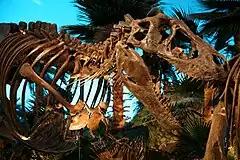
The Children's Museum of Indianapolis is the largest of its kind in the world, with 433,000 square feet (40,227.02 m2) of exhibit space and a collection of over 120,000 artifacts.[264][265] Because of its leadership and innovations, the museum is a world leader in its field.[266] Child and Parents magazine have both ranked the museum as the best children's museum in the U.S.[267] It is one of the city's most popular attractions, drawing nearly 1.3 million visitors in 2019.[268]
The Indianapolis Zoo houses more than 1,400 animals of 235 species while the adjoining White River Gardens contains more than 50,000 plants of nearly 3,000 species, respectively.[269] The zoo is a leader in animal conservation and research, recognized for its biennial Indianapolis Prize award.[270] It is the only American zoo accredited as a zoo, aquarium, and zoological garden by the Association of Zoos and Aquariums.[271] It is among the largest privately funded zoos in the U.S.[272] and one of the city's most visited attractions, with 1.1 million guests in 2019.[268]
The Indianapolis Motor Speedway Museum exhibits an extensive collection of auto racing memorabilia showcasing various motorsports and automotive history.[273] Daily grounds and track tours originate from the museum. Located at the National Collegiate Athletic Association headquarters, the NCAA Hall of Champions contains exhibits on collegiate athletics in the U.S.[274]
Institutions chronicling state history in Indianapolis include the Indiana Historical Society, Indiana State Museum, and Indiana Medical History Museum. Indiana Landmarks, the largest nonprofit statewide historic preservation organization in the U.S., is also based in the city.[275] The Benjamin Harrison Presidential Site, in the Old Northside Historic District, is open for daily tours and contains archives and memorabilia from the 23rd President of the United States. President Harrison is buried about 3 miles (4.8 km) north of the site at Crown Hill Cemetery, listed on the National Register of Historic Places. Other notable graves include three U.S. Vice Presidents (Fairbanks, Hendricks, and Marshall) and notorious American gangster, John Dillinger.[276]
Two museums and several memorials in the city commemorate armed forces or conflict, including the Colonel Eli Lilly Civil War Museum and Indiana World War Memorial Military Museum at the Indiana World War Memorial Plaza. Outside of Washington, D.C., Indianapolis contains the largest collection of monuments dedicated to veterans and war casualties in the nation.[27][28] Other notable sites are the Crown Hill National Cemetery, Indiana 9/11 Memorial, Medal of Honor Memorial, Soldiers' and Sailors' Monument, and the USS Indianapolis National Memorial.
Beginning construction in 1836, the Indiana Central Canal is the oldest extant artificial facility in the city, recognized as an American Water Landmark since 1971.[277] Between 1985 and 2001, nearly 1.5 miles (2.4 km) of the former canal in downtown Indianapolis were reconstructed to link several cultural institutions.[278] This section, known as the Canal Walk, is flanked by walking and bicycling paths and offers gondola rides, pedal boats, kayaks, and surrey rentals.
Indianapolis is home to dozens of annual festivals and events showcasing local culture. The "Month of May" (a series of celebrations leading to the Indianapolis 500) is perhaps the largest annual celebration in the city, with the 500 Festival Parade regularly drawing 300,000 spectators.[279] Other notable events include Indiana Black Expo, Indiana State Fair, Indy Pride Festival, and Historic Irvington Halloween Festival.
Cuisine
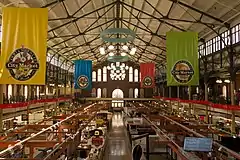
Indianapolis has an emerging food scene as well as established eateries.[280] Founded in 1821 as the city's public market, the Indianapolis City Market has served the community from its current building since 1886. Prior to World War II, the City Market and neighboring Tomlinson Hall were home to meat and vegetable vendors. As consumer habits evolved and residents moved from the central city, City Market transitioned from a traditional marketplace to a food hall.[281] In addition to City Market, The AMP and The Garage food halls opened in 2021.[282]
Situated in the Corn Belt, Indianapolis has maintained close ties to farming and food production. Urban agriculture in the city dates to the 1930s, when non-profit organization Flanner House began teaching Black arrivals how to farm on vacant lots during the Great Migration. Within a few years, more than 200 families were tending 600 garden plots on nearly 100 acres (40 ha) of land on the city's near north side.[283] Urban agriculture has made a comeback in recent years in an effort to alleviate food deserts.[284] According to the city's Office of Sustainability, there were 129 community farms and gardens in 2020.[285] As of 2020, several farmers' markets have been established throughout Indianapolis.[286]
Distinctive local dishes include pork tenderloin sandwiches[287] and sugar cream pie. The beef Manhattan, invented in Indianapolis, can also be found on restaurant menus throughout the city and region.[288] Longstanding local eateries include Long's Bakery, Mug-n-Bun, Shapiro's,[289] and St. Elmo Steak House, best known for its signature shrimp cocktail.[290] In 2012, St. Elmo was recognized with the America's Classics award by the James Beard Foundation.[291] In 2008, the Indianapolis metropolitan area had the highest concentration of chain restaurants per capita in the U.S.[292] The city's growing immigrant population has contributed to a rise in global cuisine, with the openings of some 800 ethnic restaurants in recent years.[293]
In 2016, Condé Nast Traveler named Indianapolis the "most underrated food city in the U.S.", while ranking Milktooth as one of the best restaurants in the world.[294][295] Food & Wine called Indianapolis the "rising star of the Midwest", recognizing Milktooth, Rook, Amelia's, and Bluebeard, all in Fletcher Place.[296][297] Several Indianapolis chefs and restaurateurs have been semifinalists in the James Beard Foundation Awards in recent years.[298][299] Microbreweries have become a staple in the city, increasing fivefold since 2009.[300] There are now about 50 craft brewers in Indianapolis, with Sun King Brewing being the largest.[301]
Film and television
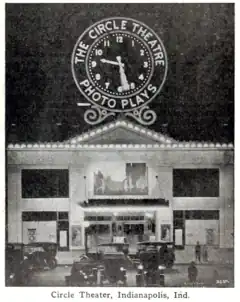
Indianapolis natives have left a mark on the entertainment industry, most notably during the Classical Hollywood cinema era. James Baskett received an Academy Honorary Award in 1948 for his role in Walt Disney's Song of the South, becoming the first Black male to receive an Oscar. Sid Grauman, one of the founders of the Academy of Motion Picture Arts and Sciences, received an Academy Honorary Award in 1949, recognized for raising the standard for film exhibition. Perhaps the most famous actor from the Indianapolis area is Academy Award-nominee, Steve McQueen, who was born in Beech Grove. Other Academy Award nominees from the city include costume designer Gloria Gresham, actress Marjorie Main, and actor Clifton Webb.[303]
The city's storied sports venues have served as a backdrop for such films as Hoosiers (1986) and Eight Men Out (1988).[304] The city's largest contribution to popular culture, the Indianapolis 500, has influenced entertainment for decades, referenced in film, television, video games, and other media.[305] Three motion pictures filmed at the Indianapolis Motor Speedway include Speedway (1929), To Please a Lady (1950), and Winning (1969).[306] Other motion pictures at least partially filmed in the city include Going All the Way (1997), Palindromes (2004), Saving Star Wars (2004), Amanda (2009), Walter (2015), The MisEducation of Bindu (2019),[307] Athlete A (2020), and Our Father (2022). Hoosiers and Ringling Brothers Parade Film (1902) were added to the National Film Registry in 2001 and 2021, respectively.[308][309]
Indianapolis natives Jane Pauley and David Letterman launched their Emmy Award-winning broadcasting careers in local media, Pauley with WISH-TV and Letterman with WTHR, respectively.[310][311] Television programs that have shot on location in the city include American Ninja Warrior,[312] Antiques Roadshow,[313] Cops,[314] Diners, Drive-Ins and Dives,[315] Extreme Makeover: Home Edition,[316] Gaycation,[317] Ghost Hunters,[318] Good Bones,[319] Hard Knocks,[320] House Hunters,[321] Late Night with Jimmy Fallon,[322] Man v. Food,[315] Parks and Recreation,[323][324] Say I Do,[325] SportsCenter,[326] Today,[327] and What Would You Do?[328]
Annual film festivals held in Indianapolis include the Circle City Film Festival, Heartland International Film Festival,[329] Indianapolis International Film Festival, Indianapolis Jewish Film Festival, and Indianapolis LGBT Film Festival. Founded in 2018, the Indy Shorts International Film Festival is one of 34 film festivals in the world used to qualify for the Academy Awards.[330]
Film Indy was established in 2016 to support local visual artists, filmmakers, and aspiring filmmakers; recruit film and television-related marketing opportunities to the region, and provide resources for producers interested in filming in the city.[315] Since 2016, more than 350 film and media projects have been produced in the Indianapolis region with a collective economic impact of $24.1 million and the creation of 1,900 local jobs.[331]
Sports
Professional
.jpg.webp)
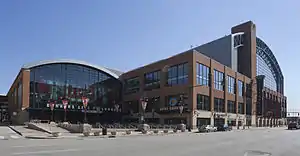
The Indianapolis Colts of the National Football League (NFL) have been based in the city since relocating from Baltimore in 1984. The Colts' tenure in Indianapolis has produced 11 division championships, two conference championships, and two Super Bowl appearances. Pro Football Hall of Famer Peyton Manning led the team to win Super Bowl XLI in the 2006 NFL season.[332] Lucas Oil Stadium replaced the team's first home, the RCA Dome, in 2008.[333]
Founded in 1967, the Indiana Pacers began in the American Basketball Association (ABA), joining the National Basketball Association (NBA) when the leagues merged in 1976. Before joining the NBA, the Pacers won three division titles and three championships (1970, 1972, 1973). Since the merger, the Pacers have won one conference title and six division titles, most recently in 2014.[334] Founded in 2000, the Indiana Fever of the Women's National Basketball Association (WNBA) have won three conference titles and one championship in 2012.[335] The Fever and Pacers share Gainbridge Fieldhouse, which replaced Market Square Arena in 1999.[336]
The Indianapolis Indians of the International League are the second-oldest minor league franchise in American professional baseball, having been established in 1902.[337] The Indians have won 26 division titles, 14 league titles, and seven championships, most recently in 2000. The team has played at Victory Field since 1996.[338]
Other local minor league franchises include the Indy Eleven soccer team of the USL Championship (USLC), who play their home matches at Michael A. Carroll Stadium, and the Indy Fuel hockey team of the ECHL, who play their home games at the Indiana Farmers Coliseum. Both teams premiered in 2014.[339][340]
Amateur
Indianapolis has been called the "Amateur Sports Capital of the World".[43][341] The National Collegiate Athletic Association (NCAA), the main governing body for U.S. collegiate sports, and the National Federation of State High School Associations are based in Indianapolis.[274] The city is home to two NCAA athletic conferences: the Horizon League (D-I) and the Great Lakes Valley Conference (D-II). Indianapolis is also home to three national sport governing bodies, as recognized by the U.S. Olympic & Paralympic Committee: USA Football; USA Gymnastics; and USA Track & Field.[342]
Butler University and IUPUI are D-I schools. The Butler Bulldogs compete in the Big East Conference while the IUPUI Jaguars compete in the Horizon League.[343] The University of Indianapolis is a D-II school; the Greyhounds compete in the Great Lakes Valley Conference. Marian University athletics compete in the NAIA's Crossroads League.
Traditionally, Butler's Hinkle Fieldhouse was the hub for Hoosier Hysteria, a general excitement for the game of basketball throughout the state, specifically the Indiana High School Boys Basketball Tournament.[344] Hinkle, a National Historic Landmark, opened in 1928 as the world's largest basketball arena, with seating for 15,000.[345] It is regarded as "Indiana's Basketball Cathedral".[346] Perhaps the most notable game was the 1954 state championship, which inspired the critically acclaimed film, Hoosiers.[347][348]
Events
Indianapolis hosts numerous sporting events annually, including the OneAmerica 500 Festival Mini-Marathon (1977–present),[349] Circle City Classic (1984–present),[350] NFL Scouting Combine (1987–present), Monumental Marathon (2008–present), and Big Ten Football Championship Game (2011–present). Indianapolis is also a regular host of the NCAA Division I men's basketball tournament (1980, 1991, 1997, 2000, 2006, 2010, 2015, and 2021).[351]
Notable past events include the National Sports Festival (1982); NBA All-Star Game (1985); Pan American Games X (1987); US Open Series Indianapolis Tennis Championships (1988–2009); World Artistic Gymnastics Championships (1991); WrestleMania VIII (1992); World Rowing Championships (1994); United States Grand Prix (2000–2007); World Police and Fire Games (2001); FIBA Basketball World Cup (2002); NCAA Division I women's basketball tournament (2005, 2011, and 2016); Super Bowl XLVI (2012); and the College Football Playoff National Championship (2022).
Motorsports
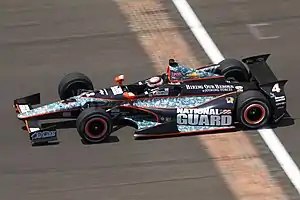
Indianapolis is a major center for motorsports. Two auto racing sanctioning bodies are headquartered in the city (INDYCAR and United States Auto Club) along with more than 500 motorsports companies and racing teams, employing some 10,000 people in the region.[352] Indianapolis or Indy is a metonym for auto racing, used for both the competition and type of car used in it.[353]
Completed in 1909 as an automotive test track, the Indianapolis Motor Speedway is a National Historic Landmark and the world's largest sports venue by capacity, with 235,000 permanent seats.[354] Since 1911, the 2.5-mile-long (4.0 km) rectangular oval has hosted the Indianapolis 500, an open-wheel automobile race held annually on Memorial Day weekend. Considered part of the Triple Crown of Motorsport, the Indianapolis 500 is the world's largest single-day sporting event.[25][26] The track's combined road course also hosts the Grand Prix of Indianapolis and NASCAR's Verizon 200 at the Brickyard and Pennzoil 150.[355]
Completed in 1960, Lucas Oil Indianapolis Raceway Park (in nearby Brownsburg) contains a 2.5-mile-long (4.0 km) road course, a 4,400-foot-long (1,300 m) dragstrip, and a 0.69-mile-long (1.11 km) oval short track. Each Labor Day weekend, the facility hosts the National Hot Rod Association (NHRA) U.S. Nationals, the largest and most prestigious drag racing event in the world.[356][357]
Government
Indianapolis—officially the Consolidated City of Indianapolis and Marion County—has a consolidated city-county form of government, a status it has held since 1970 under Indiana Code's Unigov provision. Many functions of the city and county governments are consolidated, though some remain separate.[3] The city has a strong mayor–council form of government overseeing six administrative departments. Marion County also contains some 60 taxing units, nine separate civil township governments, and seven special-purpose municipal corporations.[358][359]
The executive branch is headed by an elected mayor, who serves as the chief executive of both the city and county.[360] Joe Hogsett is the 49th and current mayor of Indianapolis. Indianapolis City-County Council is the legislative body and consists of 25 members, all of whom represent geographic districts. The mayor and council members are elected to unlimited four-year terms.[360][361] The judiciary consists of a circuit court and superior court with four divisions and 32 judges.[3] Each of the county's nine civil townships elects its own township trustee, three-member board, assessor, and a constable and small claims court judge, all of whom serve four-year terms.[89]
Since its move from Corydon in 1825, Indianapolis has served as the capital and seat of Indiana's state government. The Indiana Statehouse houses the executive, legislative, and judicial branches of state government, including the office of the Governor of Indiana, the Indiana General Assembly, and the Indiana Supreme Court. Most state departments and agencies are based in the neighboring Indiana Government Center complex.[362] The Indiana Governor's Residence is on Meridian Street in the Butler–Tarkington neighborhood, about 5 miles (8.0 km) north of downtown.
In the Indiana House of Representatives, Indianapolis is split between 16 districts.[363] In the Indiana Senate, the city is split between nine districts.[364] Indianapolis is split between two of Indiana's nine congressional districts: Indiana's 7th congressional district, represented by André Carson, and Indiana's 6th congressional district, represented by Greg Pence.
The Birch Bayh Federal Building and United States Courthouse houses the United States District Court for the Southern District of Indiana. Most federal field offices are located in the Minton-Capehart Federal Building. The Defense Finance and Accounting Service, an agency of the U.S. Department of Defense, is headquartered in neighboring Lawrence.[365]
Politics
Until fairly recently, Indianapolis was considered one of the most conservative major cities in the U.S.[366][69] According to 2014 research published in the American Political Science Review, the city's policy preferences are less conservative than the national mean when compared with other large U.S. cities.[367] While Indianapolis as a whole leans Democratic, the southern third of the city, consisting of Decatur, Perry, and Franklin townships, trends Republican.[368]
Republicans held the mayor's office for 32 years (1967–1999), and controlled the City-County Council from its inception in 1970 to 2003.[69] In the 2000 United States presidential election, Marion County voters narrowly selected George W. Bush over Al Gore by a margin of 1.3%, but voted in favor of John Kerry by a margin of 1.9% in the 2004 United States presidential election. Presidential election results have increasingly favored Democrats, with Marion County voters selecting Joe Biden over Donald Trump in the 2020 United States presidential election, 63.3–34.3%.[369] Incumbent mayor Democrat Joe Hogsett faced Republican State Senator Jim Merritt and Libertarian Doug McNaughton in the 2019 Indianapolis mayoral election. Hogsett was elected to a second term, with 72% of the vote.[370] The 2019 City-County Council elections expanded Democratic control of the council, flipping six seats to hold a 20–5 supermajority over Republicans.[371]
Human resources
Public health
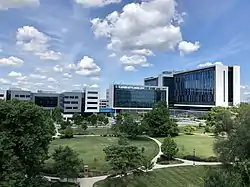
Healthcare in Indianapolis is provided by more than 20 hospitals, most belonging to the private, non-profit healthcare systems of Ascension St. Vincent Health, Community Health Network, and Indiana University Health. Several are teaching hospitals affiliated with the Indiana University School of Medicine or Marian University College of Osteopathic Medicine.
Health and Hospital Corporation of Marion County, a municipal corporation, was formed in 1951 to manage the city's public health facilities and programs, including the Marion County Public Health Department, Indianapolis Emergency Medical Services, and Eskenazi Health.[372] Eskenazi Health operates 12 primary care centers across the city, including its flagship Sidney & Lois Eskenazi Hospital. Established in 1932, the Veterans Health Administration's Richard L. Roudebush VA Medical Center serves nearly 70,000 veterans annually.[373] The NeuroDiagnostic Institute, a 159-bed psychiatric hospital overseen by the Indiana Family and Social Services Administration, opened in 2019.[374]
Indiana University Health's Methodist Hospital, University Hospital, and Riley Hospital for Children are affiliated with the Indiana University School of Medicine, the largest medical school by enrollment in the U.S.[375][376][377] Riley Hospital for Children is among the nation's foremost pediatric health centers, recognized in all ten specialties by U.S. News & World Report.[378] The 430-bed facility is Indiana's only Pediatric Level I Trauma Center.[379] In 2020, IU Health detailed plans to consolidate and replace Methodist and University hospitals with a new $1.6 billion academic medical center, to open in 2026.[380]
Other major private, non-profit hospitals based in the city include Ascension St. Vincent Hospital Indianapolis, Community Hospital East, Community Hospital North, and Franciscan Health Indianapolis.
Public safety

Indianapolis Metropolitan Police Department (IMPD) is the primary law enforcement agency for the city of Indianapolis. IMPD's jurisdiction covers Marion County, excluding the municipalities of Beech Grove, Lawrence, Southport, and Speedway. In 2020, IMPD had 1,700 sworn police personnel and 250 civilian employees across six districts.[381] In 2022, the Community Justice Campus opened, housing the Marion County Sheriff's Office, a new courthouse, jail, and mental health and substance abuse clinic.[382]
Unlike other major Midwest cities like Detroit and Chicago, the homicide rate for Indianapolis remained below the national average throughout the 1990s. [383] Homicides hit a spike in 1998 when the city reached 162 murders. Murders drastically decreased in the following years but spiked again in 2006 with 153 murders.[384] Until 2019, annual criminal homicide numbers had grown each year since 2011, reaching record highs from 2015 to 2018.[385] With 144 criminal homicides, 2015 surpassed 1998 as the year with the most murder investigations in the city. With 159 criminal homicides, 2018 stands as the most violent year on record in the city.[385] FBI data showed a 7% increase in violent crimes committed in Indianapolis, outpacing the rest of the state and country.[386] Law enforcement has blamed increased violence on a combination of root causes, including poverty, substance abuse, and mental illness.[387]
Indianapolis Fire Department (IFD) provides fire protection and rescue services as the primary emergency response agency for 278 square miles (720 km2) of Marion County. IFD provides mutual aid to the excluded municipalities of Beech Grove, Lawrence, and Speedway, as well as Decatur, Pike, and Wayne townships which have retained their own fire departments.[388] The fire district comprises seven geographic battalions with 43 fire stations.[389] Some 1,200 firefighters respond to more than 161,000 incidents annually.[390] IFD directs operations for Indiana Task-Force One (IN-TF1), one of 28 FEMA Urban Search and Rescue Task Force teams in the U.S.[388]
Indianapolis Emergency Medical Services (IEMS) is the largest provider of pre-hospital medical care in Indiana and responds to 120,000 emergency dispatch calls annually.[391] Similar to IFD, the agency's coverage area excludes Decatur, Pike, and Wayne townships, and the town of Speedway.
Education
Primary and secondary education
Of Marion County's eleven K–12 public school districts, nine serve Indianapolis residents:
- Franklin Township Community School Corporation
- Indianapolis Public Schools (IPS)
- Metropolitan School District of Decatur Township
- Metropolitan School District of Lawrence Township
- Metropolitan School District of Pike Township
- Metropolitan School District of Warren Township
- Metropolitan School District of Washington Township
- Metropolitan School District of Wayne Township
- Perry Township Schools
IPS is the largest district in the city with an annual enrollment of 23,000 students attending 60 schools.[392] In 2015, IPS began contracting with charter organizations and nonprofit school managers to operate failing district schools as innovation schools.[393] About 37% of IPS students are enrolled in 20 innovation schools, which are run independently but accountable to the Board of School Commissioners, with the remaining 63% of students attending 39 neighborhood or magnet schools.[394][395] About 18,000 students are enrolled in tuition-free Mayor-Sponsored Charter Schools (MSCS), as authorized by the Indianapolis Mayor's Office of Education Innovation and Indianapolis Charter School Board.[396]
Two state-supported residential schools located in the city are the Indiana School for the Blind and Visually Impaired and Indiana School for the Deaf. According to the Indiana Department of Education, about 75 private, parochial, and independent charter schools operate throughout Marion County. Roman Catholic and Christian parochial primary and secondary schools are most prevalent.[397][398]
Higher education
Indianapolis's higher education landscape is dominated by Indiana University–Purdue University Indianapolis (IUPUI), a public university formed in 1969 after the branch campuses of Indiana University and Purdue University merged.[343] IUPUI is classified as an urban research university, enrolling about 30,000 students in 450 undergraduate, graduate, and professional programs offered by 17 schools.[399][343] Notable schools include the Herron School of Art and Design, Kelley School of Business, McKinney School of Law, O'Neill School of Public and Environmental Affairs, and the Indiana University School of Medicine, the largest medical school in the U.S.[375][376][377]
Indiana's statewide community college system, Ivy Tech, enrolls some 21,000 full-time students at two full-service campuses, one learning site, and the Automotive Technology Center in the Indianapolis service area.[400][401] Other public institutions with satellite campuses in the city include Ball State University's Estopinal College of Architecture and Planning,[402] Purdue Polytechnic Institute, and Vincennes University.[403]
Two secular private universities are based in Indianapolis. Founded in 1855, Butler University serves an enrollment of about 5,000 from its Butler–Tarkington campus.[404][405] Martin University, Indiana's only Predominantly Black Institution, was founded in 1977 and is located in the Martindale–Brightwood neighborhood.[406] Indiana Tech maintains a branch campus in the city.[407] Two seminaries are located in the city: Bishop Simon Bruté College Seminary and Christian Theological Seminary.[408] Three religiously affiliated universities located in the city are Indiana Bible College, University of Indianapolis,[405] and Marian University.[405] Indiana Wesleyan University operates a satellite campus in Indianapolis.[409]
More than 40 collegiate fraternities and sororities are headquartered in the Indianapolis metropolitan area, the largest concentration in North America.[410][411]
Media
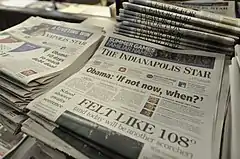
Indianapolis is served by various print media. Founded in 1903, The Indianapolis Star is the city's daily morning newspaper. The Star is owned by Gannett Company, with a daily circulation of 127,064.[412] The Indianapolis News was the city's daily evening newspaper and oldest print media, published from 1869 to 1999. Notable weeklies include NUVO, an alternative weekly newspaper, the Indianapolis Recorder, a weekly newspaper serving the local African American community, the Indianapolis Business Journal, reporting on local real estate news, and the Southside Times. Indianapolis Monthly is the city's monthly lifestyle publication.
Broadcast television network affiliates include WTTV 4 (CBS), WRTV 6 (ABC), WISH-TV 8 (The CW), WTHR-TV 13 (NBC), WDNI-CD 19 (Telemundo), WFYI-TV 20 (PBS), WNDY-TV 23 (MyNetworkTV), WUDZ-LD 28 (Buzzr), WSDI-LD 30 (Ve Plus TV), WHMB-TV 40 (Family), WCLJ-TV 42 (Bounce TV), WALV-CD 46 (MeTV), WBXI-CD 47 (Start TV), WXIN-TV 59 (Fox), WIPX-TV 63 (Ion) and WDTI 69 (Daystar). In 2019, the Indianapolis metropolitan area was the 25th largest television market in the U.S.[413]
The majority of commercial radio stations in the city are owned by Cumulus Media, iHeartMedia, and Urban One. Popular nationally syndicated radio program The Bob & Tom Show has been based at Indianapolis radio station WFBQ since 1983.[414] In 2019, the Indianapolis metropolitan area was the 39th largest radio market in the U.S.[415]
Infrastructure
Transportation
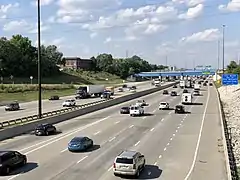
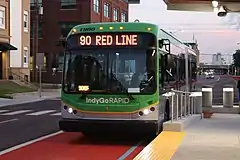

Indianapolis's transportation infrastructure consists of a complex network that includes a local public bus system, several private intercity bus providers, Amtrak passenger rail service, four freight rail lines, four primary and two auxiliary Interstate Highways, two airports, a heliport, bikeshare system, 115 miles (185 km) of bike lanes,[285] and 110 miles (177 km) of trails and greenways.[416][285] Private ridesharing companies Lyft and Uber as well as taxicabs operate in the city.[417] Launched in 2018, electric scooter-sharing systems operating in Indianapolis include Bird, Lime, and Veo.[418]
Urban sprawl and the absence of a comprehensive regional public transit system have contributed to Indianapolis residents driving more vehicle miles per capita than any other U.S. city.[419] According to the 2016 American Community Survey, 83.7% of working residents in the city commuted by driving alone, 8.4% carpooled, 1.5% used public transportation, and 1.8% walked. About 1.5% used all other forms of transportation, including taxicab, motorcycle, and bicycle. About 3.1% of working city residents worked at home.[420] In 2015, 10.5 percent of Indianapolis households lacked a car, which decreased to 8.7 percent in 2016, the same as the national average in that year. Indianapolis averaged 1.63 cars per household in 2016, compared to a national average of 1.8.[421]
Four primary Interstate Highways intersect the city: Interstate 65, Interstate 69, Interstate 70, and Interstate 74. The metropolitan area also has two auxiliary Interstate Highways: a beltway (Interstate 465) and connector (Interstate 865). A $3 billion expansion project to extend Interstate 69 from Evansville to Indianapolis is in progress.[422] The Indiana Department of Transportation manages all Interstates, U.S. Highways, and Indiana State Roads within the city. The city's Department of Public Works maintains more than 3,400 miles (5,472 km) of streets and 510 bridges,[423] in addition to alleys, sidewalks, and curbs.
Sidewalks are absent from nearly 2,000 miles (3,219 km) of the city's roadways.[423] Walk Score has ranked Indianapolis as one of the least walkable large cities in the U.S.[424] However, city officials have increased investments in bicycle and pedestrian infrastructure in recent years.[419] About 110 miles (180 km) of trails and greenways form the core of the city's active transportation network, connecting into 115 miles (185 km) of on-street bike lanes.[425][285] Popular routes include the Fall Creek Greenway, Monon Trail, and Pleasant Run Greenway.[416] The privately managed Indianapolis Cultural Trail operates Indiana Pacers Bikeshare, the city's bicycle-sharing system, which consists of 525 bicycles at 50 stations.[426]
IndyGo operates and manages the city's public bus system, including bus rapid transit, microtransit, and paratransit services. The Julia M. Carson Transit Center serves as the downtown hub for 27 of its 31 fixed routes.[427][416] In 2020, IndyGo's fleet of 212 buses provided about 4.8 million passenger trips (compared with pre-COVID-19 pandemic ridership of 9.2 million in 2019).[428] The Central Indiana Regional Transportation Authority (CIRTA) is a quasi-governmental agency that organizes regional car and vanpools and operates three public shuttle buses connecting Indianapolis to employment centers in suburban Plainfield and Whitestown.[429]
Indianapolis International Airport's Colonel H. Weir Cook Terminal contains two concourses and 40 gates, connecting to 51 nonstop domestic and international destinations and averaging 145 daily departures.[430] IND is the busiest airport in the state, serving more than 9.5 million passengers in 2019.[431] As home to the second largest FedEx Express hub in the world, IND ranks among the ten busiest U.S. airports in terms of air cargo throughput.[432] Indianapolis Airport Authority, a municipal corporation, oversees operations at five additional aviation facilities in the region, two of which are located in the city: Eagle Creek Airpark and the Indianapolis Downtown Heliport.[433]
Indianapolis Union Station is the state's primary intercity bus transfer hub, served by seven carriers operating 12 routes.[434] Amtrak's Cardinal operates three weekly trips between New York City and Chicago. The Beech Grove Shops in the enclave of Beech Grove serves as Amtrak's primary heavy maintenance and overhaul facility, while the Indianapolis Distribution Center is the company's largest material and supply terminal.[435][436] About 282 miles (454 km)[416] of freight rail lines converge in the city, including one Class I railroad (CSX Transportation), one Class II railroad (Indiana Rail Road Company), and two shortline railroads (Indiana Southern Railroad and Louisville and Indiana Railroad). Indianapolis is a hub for CSX Transportation, home to its division headquarters, an intermodal terminal, and classification yard in the suburb of Avon.[437]
Utilities

AES Indiana supplies electricity to more than 500,000 Indianapolis customers[438] and maintains 90,000 street lights.[439] Natural gas, water, and wastewater utilities are provided by Citizens Energy Group.[440] The company's thermal division operates the Perry K. Generating Station which produces and distributes steam for heating and cooling to about 160 customers in downtown Indianapolis.[441] The city's water supply is sourced from the White River and its tributaries as well as aquifers via four surface water treatment plants, four reservoirs, and five groundwater pumping stations throughout the region.[442]
Area codes 317 and 463 are telephone area codes in the North American Numbering Plan assigned to Indianapolis and seven surrounding counties in Central Indiana. Established in 1947, 317 is the original area code for the Indianapolis area, while 463 is an overlay code for the same area that was added in 2016, making ten-digit dialing mandatory for all calls in the region.[443] Telecommunications, including cable television, internet, telephone, and wireless services, are provided by AT&T Communications, Metronet, Spectrum, Verizon Communications, and Xfinity.[444]
Waste collection services in Indianapolis are provided by the city's Department of Public Works Solid Waste Division, Republic Services, and WM.[445] Solid waste disposal in the city is processed by landfill and incineration. Covanta operates a waste-to-energy plant in the city. About 11% of residents subscribe to private curbside recycling services;[446] however, free public recycling drop-off sites are available throughout the city.[447] Of U.S. cities, Indianapolis is the largest without a universal curbside recycling program, resulting in one of the lowest landfill diversion rates.[446][448]
International relations
Sister cities

Indianapolis has ten sister cities.[449][lower-alpha 3] Listed alphabetically, they are:
 Campinas (Brazil)
Campinas (Brazil) Cologne (Germany)
Cologne (Germany) Hangzhou (China)
Hangzhou (China) Hyderabad (India)
Hyderabad (India) Monza (Italy)
Monza (Italy) Northamptonshire (United Kingdom)
Northamptonshire (United Kingdom)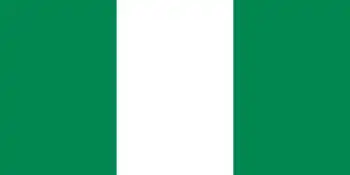 Onitsha (Nigeria)
Onitsha (Nigeria) Piran (Slovenia)
Piran (Slovenia) Santiago de Querétaro (Mexico)
Santiago de Querétaro (Mexico) Taipei (Taiwan)
Taipei (Taiwan)
See also
Notes
- Mean monthly maxima and minima (i.e. the expected highest and lowest temperature readings at any point during the year or given month) calculated based on data at said location from 1991 to 2020.
- Official records for Indianapolis kept at downtown from February 1871 to December 1942, and at Indianapolis Int'l since January 1943. For more information, see Threadex
- Indianapolis has one former sister city, Scarborough, Ontario, Canada. The relationship was formally established in 1996 but dissolved following the 1998 amalgamation of Toronto.[450][451]
References
- Bodenhamer, David J.; Barrows, Robert G., eds. (1994). The Encyclopedia of Indianapolis. Bloomington and Indianapolis: Indiana University Press. pp. 1266–1267. ISBN 0-253-31222-1.
- Bodenhamer, David; Barrows, Robert, eds. (1994). The Encyclopedia of Indianapolis. Bloomington and Indianapolis: Indiana University Press. pp. 1479–1480. ISBN 0-253-31222-1.
- "Unigov Handbook: A Citizen's Guide to Local Government" (PDF). League of Women Voters of Indianapolis. Archived from the original (PDF) on March 13, 2017. Retrieved March 12, 2017.
- "2020 U.S. Gazetteer Files". U.S. Census Bureau. Retrieved March 16, 2022.
- "Indianapolis". Geographic Names Information System. United States Geological Survey, United States Department of the Interior. Retrieved April 10, 2021.
- "2020 Population and Housing State Data". U.S. Census Bureau. Retrieved August 22, 2021.
- "Indianapolitan". Merriam-Webster.com Dictionary. Retrieved August 1, 2016.
- "U.S. Census Bureau". U.S. Census Bureau. Retrieved January 31, 2008.
- Jones, Daniel (2003) [1917]. Peter Roach; James Hartmann; Jane Setter (eds.). English Pronouncing Dictionary. Cambridge: Cambridge University Press. ISBN 3-12-539683-2.
- "QuickFacts". U.S. Census Bureau. Retrieved October 22, 2023.
- "Indianapolis-Carmel-Anderson, IN Metro Area". Indiana Business Research Center, Indiana University, Kelley School of Business. Retrieved October 22, 2023.
- "Indianapolis-Carmel-Muncie, IN Combined Area". Indiana Business Research Center, Indiana University, Kelley School of Business. Retrieved October 22, 2023.
- James R. Jones III, PhD.; Amy L. Johnson (2016). "Early Peoples of Indiana" (PDF). Indiana Department of Natural Resources Division of Historic Preservation and Archaeology. Archived from the original (PDF) on July 25, 2020. Retrieved August 11, 2020.
- Bodenhamer, David; Robert Graham Barrows; David Gordon Vanderstel (1994). The Encyclopedia of Indianapolis. Indiana University Press. ISBN 0-253-31222-1. p. 1042
- Bodenhamer, David; Barrows, Robert, eds. (1994). The Encyclopedia of Indianapolis. Bloomington & Indianapolis: Indiana University Press. p. 190.
- "Metro Indianapolis Export Plan" (PDF). Indy Chamber. Archived from the original (PDF) on October 22, 2016. Retrieved August 16, 2016.
- "Capital at the Crossroads of America–Indianapolis: A Discover Our Shared Heritage Travel Itinerary". National Park Service (U.S. Dept. of the Interior). Retrieved March 24, 2016.
- "Total Gross Domestic Product for Indianapolis-Carmel-Anderson, IN (MSA) [NGMP26900]". U.S. Bureau of Economic Analysis. FRED, Federal Reserve Bank of St. Louis. Retrieved May 20, 2023.
- "Indianapolis Area Economic Summary" (PDF). U.S. Department of Labor Bureau of Labor Statistics. February 3, 2022. Retrieved February 15, 2022.
- Rick Mattoon; Norman Wang (2014). "Industry clusters and economic development in the Seventh District's largest cities" (PDF). Economic Perspectives. pp. 56–58. Retrieved August 16, 2016.
- Ted Greene and Jon Sweeney (January 20, 2012). Naptown to Super City (television broadcast). WFYI.
- Clark, Andrew (May 21, 2018). "Fortune 500 list: Indiana RV manufacturer makes it for the first time". The Indianapolis Star. Retrieved August 2, 2019.
- Quinn, Samm (January 2, 2020). "Children's museum reports record attendance in 2019". Indianapolis Business Journal. Retrieved August 12, 2020.
- Keefer, Zak (April 30, 2016). "How the Indianapolis 500 became more than a race". The Indianapolis Star. Gannett Co. Retrieved May 29, 2022.
- Davidson, Donald (2021) [1994]. "Indianapolis 500-Mile Race". Digital Encyclopedia of Indianapolis. Indianapolis Public Library. Retrieved May 29, 2022.
- Mitchell, Dawn (May 25, 2015). "Monumental Indianapolis: Touring Indianapolis memorials". The Indianapolis Star. Retrieved March 25, 2016.
- "Message from the Executive Director". Indiana War Memorial. Retrieved March 25, 2016.
- An earlier use of the name dates to the 1760s when it referenced a tract of land under the control of the Commonwealth of Virginia, but the area's name was discarded when it became a part of that state. See Hodgin, Cyrus (1903). "The Naming of Indiana" (pdf transcription). Papers of the Wayne County, Indiana, Historical Society. Wayne County, Indiana, Historical Society. 1 (1): 3–11. Retrieved January 23, 2014.
- "Judge Jeremiah Sullivan House". National Park Service (U.S. Dept. of the Interior). Retrieved August 21, 2017.
- A plaque at the City-County Building commissioned by the Society of Indiana Pioneers in 1962 lists these as considered names: "In an act of January 6, 1821, the Indiana General Assembly, then meeting at Corydon, named the new capital of the state 'Indianapolis'. Jeremiah Sullivan, later an eminent Hoosier jurist, acting in cooperation with Samuel Merrill and the approval of Governor Jonathan Jennings, proposed Indianapolis as the name which was chosen in preference to Tecumseh, Suwarrow, and Concord."
- A. C. Howard (1857). A. C. Howard's Directory for the City of Indianapolis: Containing a Correct List of Citizens' Names, Their Residence, and Place of Business, with a Historical Sketch of Indianapolis from its Earliest History to the Present Day. Indianapolis: A. C. Howard. p. 3. See also Hester Ann Hale (1987). Indianapolis, the First Century. Indianapolis: Marion County Historical Society. p. 9.
- Brown, p. 1; Centennial History of Indianapolis, p. 26; and Howard, p. 2.
- James H. Madison (2014). Hoosiers: A New History of Indiana. Bloomington and Indianapolis: Indiana University Press and the Indiana Historical Society Press. p. 123. ISBN 978-0-253-01308-8.
- Baer, p. 10 and 58.
- Brown, p. 2; Centennial History of Indianapolis, p. 6; and Hale, p. 8.
- Hale, p. 9.
- Hyman, p. 10, and William A. Browne Jr. (Summer 2013). "The Ralston Plan: Naming the Streets of Indianapolis". Traces of Indiana and Midwestern History. Indianapolis: Indiana Historical Society. 25 (3): 8–9. Accessed March 25, 2016.
- Brown, pp. 8, 46 and 49; Centennial History of Indianapolis, p. 30; Esarey, v. 3, pp. 42–43 and 201–2; and Bodenhamer, David J.; Barrows, Robert G., eds. (1994). The Encyclopedia of Indianapolis. Bloomington and Indianapolis: Indiana University Press. pp. 1479–80. ISBN 0-253-31222-1.
- Bodenhamer and Barrows, eds., p. 967; Hale, p. 13; Howard, p. 26; and W. R. Holloway (1870). Indianapolis: A Historical and Statistical Sketch of the Railroad City, A Chronicle of its Social, Municipal, Commercial and Manufacturing Progress with Full Statistical Tables. Indianapolis: Indianapolis Journal.
- Baer, p. 11, and Hyman, p. 34.
- Bodenhamer, David; Barrows, Robert, eds. (1994). The Encyclopedia of Indianapolis. Bloomington & Indianapolis: Indiana University Press. pp. 395–396.
- "Indianapolis". Encyclopædia Britannica. Retrieved June 13, 2016.
- "Indianapolis Union Railroad Station". Discover Our Shared Heritage Travel Itinerary. Washington, D.C.: National Park Service. Retrieved August 11, 2015.
- Holliday, p. 24; Dunn, Greater Indianapolis, v. I, p. 217; and Leary, pp. 94–98.
- John D. Barnhart (September 1961). "The Impact of the Civil War on Indiana". Indiana Magazine of History. Bloomington: Indiana University. 57 (3): 186. Retrieved October 15, 2015.
- Joseph A. Parsons Jr. (March 1958). "Indiana and the Call for Volunteers, April, 1861". Indiana Magazine of History. Bloomington: Indiana University. 54 (1): 5–7. Retrieved October 20, 2015.
- Emma Lou Thornbrough (1995). Indiana in the Civil War Era, 1850–1880. History of Indiana. Vol. III. Indianapolis: Indiana Historical Society. p. 124. ISBN 0-87195-050-2.
- Leary, p. 99.
- Bodenhamer and Barrows, eds., p. 443.
- Leary, pp. 99, 113–14, and Bodenhamer and Barrows, eds., pp. 441, 443.
- Thornbrough, p. 202; Bodenhamer and Barrows, eds., p. 1121; and Kenneth M. Stampp (1949). Indiana Politics During the Civil War. Indiana Historical Collections. Vol. 31. Indianapolis: Indiana Historical Bureau. pp. 199–201. OCLC 952264.
- Barnhart, pp. 212–13, and John Holliday (1911). Indianapolis and the Civil War. E. J. Hecker. pp. 58–59.
- Dunn, v. I, p. 237.
- Bodenhamer, David; Barrows, Robert, eds. (1994). The Encyclopedia of Indianapolis. Bloomington & Indianapolis: Indiana University Press. p. 1483.
- Bodenhamer, David; Barrows, Robert, eds. (1994). The Encyclopedia of Indianapolis. Bloomington & Indianapolis: Indiana University Press. p. 23.
- James Philip Fadely (Winter 2006). "The Veteran and the Memorial: George J. Gangsdale and the Soldiers and Sailors Monument". Traces of Indiana and Midwestern History. Indianapolis: Indiana Historical Society. 18 (1): 33–35. Accessed March 26, 2016.
- "Community Profiles: Indianapolis, Indiana". The Great Flood of 1913, 100 Years Later. Silver Jackets. 2013. Archived from the original on November 13, 2013. Retrieved July 29, 2013.
- Trudy E. Bell (Spring 2006). "Forgotten Waters: Indiana's Great Easter Flood of 1913". Traces of Indiana and Midwestern History. Indianapolis: Indiana Historical Society. 18 (2): 15.
- Unconfirmed deaths numbered as many as twenty-five. See Bodenhamer and Barrows, p. 582.
- Bodenhamer, David J.; Barrows, Robert G., eds. (1994). The Encyclopedia of Indianapolis. Bloomington and Indianapolis: Indiana University Press. pp. 581–582. ISBN 0-253-31222-1.
- "Retro Indy: City came close to being "Motor City"". The Indianapolis Star. Gannett Co. April 24, 2016. Retrieved April 27, 2016.
- Dunn, Jacob Piatt (1919). Indiana and Indianans. Vol. III. Chicago & New York: American Historical Society. p. 1230.
- "Indianapolis" (PDF). Archived from the original (PDF) on September 26, 2006. Retrieved November 8, 2011.
- Morning Edition. "Robert Kennedy: Delivering News of King's Death". NPR.org. NPR. Retrieved July 1, 2010.
- Higgins, Will (April 2, 2015). "April 4, 1968: How RFK saved Indianapolis". The Indianapolis Star. Retrieved March 26, 2016.
- "Top 100 American Speeches of the 20th Century". Retrieved August 1, 2016.
- Cavazos, Shaina (August 17, 2016). "Racial Bias and the Crumbling of a City". The Atlantic. Retrieved September 22, 2016.
- Bradner, Eric (August 29, 2010). "Indiana Democrats, African-Americans saw diminishing returns in 'Unigov'". Evansville Courier & Press. Archived from the original on April 8, 2016. Retrieved March 26, 2016.
- Bodenhamer, David; Barrows, Robert, eds. (1994). The Encyclopedia of Indianapolis. Bloomington & Indianapolis: Indiana University Press. p. 1356.
- "Unigov's 1st Test Is Due". The Indianapolis News. May 25, 1971. p. 41. Retrieved July 3, 2023 – via Newspapers.com.
It meant the city's jurisdiction grew overnight from one that covered 82 square miles and just over 500,000 residents to one with 400 square miles and more than 750,000 people.
- Blomquist, William A.; Vanderstel, David G. (2021) [1994]. "Creation of Unigov". Digital Encyclopedia of Indianapolis. Indianapolis Public Library. Retrieved July 2, 2023.
- Frantz, Edward O. (April 2021). "Richard G. Lugar". Digital Encyclopedia of Indianapolis. Indianapolis Public Library. Retrieved July 2, 2023.
- Bodenhamer, David; Barrows, Robert, eds. (1994). The Encyclopedia of Indianapolis. Bloomington & Indianapolis: Indiana University Press. pp. 803–804.
- Blomquist, William A.; Stitt, Scott (2021) [1994]. "Stephen L. Goldsmith Administration". Digital Encyclopedia of Indianapolis. Indianapolis Public Library. Retrieved July 2, 2023.
- Schneider, Mary Beth (November 3, 1999). "Peterson leads a party revival". The Indianapolis Star. p. 1. Retrieved July 2, 2023 – via Newspapers.com.
For the first time since 1963, and for the first time since Uni-Gov was created in 1969, the voters of Marion County elected a Democrat — Bart Peterson — to be mayor.
- Frantz, Edward O. (March 2021). "Bart Peterson Administration". Digital Encyclopedia of Indianapolis. Indianapolis Public Library. Retrieved July 2, 2023.
- Colombo, Hayleigh (December 23, 2015). "Ballard: A legacy shaped by deals". Indianapolis Business Journal. Retrieved July 2, 2023.
- Frantz, Edward O. (April 2021). "Gregory Ballard Administration". Digital Encyclopedia of Indianapolis. Indianapolis Public Library. Retrieved July 2, 2023.
- Marlette, Jerry; Opsahl, Sam; Van Allen, Elizabeth J. (July 2021). "Indianapolis International Airport". Digital Encyclopedia of Indianapolis. Indianapolis Public Library. Retrieved July 2, 2023.
- Blair, Lyndsey D. (July 2021). "Lucas Oil Stadium". Digital Encyclopedia of Indianapolis. Indianapolis Public Library. Retrieved July 2, 2023.
- Fischer, Jessica Erin; Van Allen, Elizabeth J. (July 2021). "DigIndy". Digital Encyclopedia of Indianapolis. Indianapolis Public Library. Retrieved July 2, 2023.
- Lyons Davis, Katherine (April 2021). "Joseph H. Hogsett Administration". Digital Encyclopedia of Indianapolis. Indianapolis Public Library. Retrieved July 2, 2023.
- Doherty, William; Fischer, Jessica Erin (2021) [1994]. "Indianapolis Metropolitan Police Department". Digital Encyclopedia of Indianapolis. Indianapolis Public Library. Retrieved July 2, 2023.
- Spells, Alta (April 17, 2021). "Police ID gunman who killed 8 people at an Indianapolis FedEx facility as 19-year-old former employee". CNN. Retrieved October 22, 2023.
- "FBI says it interviewed FedEx mass shooter last year". Associated Press. April 16, 2021. Retrieved October 22, 2023.
- Geographic Centers of the United States (PDF) (Report). U.S. Department of the Interior, Geological Survey. p. 2. Retrieved May 5, 2022.
- "Indiana InDepth Profile: Largest Cities and Towns in Indiana (35,000+)". Indiana Business Research Center, Indiana University, Kelley School of Business. Retrieved May 22, 2017.
- Hale, Michelle (2021) [1994]. "Townships". Digital Encyclopedia of Indianapolis. Indianapolis Public Library. Retrieved January 21, 2022.
- Geib, W.J.; Schroeder, Frank C. (October 6, 1908). Soil Survey of Marion County, Indiana (PDF) (Report). U.S. Department of Agriculture, Bureau of Soils. pp. 5–6. Archived from the original (PDF) on July 8, 2022. Retrieved May 5, 2022.
- Mirsky, Arthur; Cox, Kristiana (2021) [1994]. "Geology". Digital Encyclopedia of Indianapolis. Indianapolis Public Library. Retrieved May 5, 2022.
- Holland, et al. (December 30, 2017). "Results of the 2016 Indianapolis Biodiversity Survey, Marion County, Indiana". Proceedings of the Indiana Academy of Science. 126 (2): 166–167. Retrieved May 5, 2022.
- Strunk, Kevin; Fischer, Jessica Erin (2021) [1994]. "White River". Digital Encyclopedia of Indianapolis. Indianapolis Public Library. Retrieved May 5, 2022.
- Bodenhamer, David J.; Barrows, Robert G., eds. (1994). The Encyclopedia of Indianapolis. Bloomington and Indianapolis: Indiana University Press. p. 132. ISBN 0-253-31222-1.
- William A. Browne Jr. (Summer 2013). "The Ralston Plan: Naming the Streets of Indianapolis". Traces of Indiana and Midwestern History. Indianapolis: Indiana Historical Society. 25 (3): 8 and 9.
- Browne, p. 11 and 16.
- Bodenhamer, David; Barrows, Robert, eds. (1994). The Encyclopedia of Indianapolis. Bloomington & Indianapolis: Indiana University Press. p. 1485.
- "2012 Census of Agriculture" (PDF). U.S. Department of Agriculture. Archived from the original (PDF) on May 4, 2017. Retrieved September 4, 2017.
- Bodenhamer, David J.; Barrows, Robert G., eds. (1994). The Encyclopedia of Indianapolis. Bloomington and Indianapolis: Indiana University Press. pp. 243–244. ISBN 0-253-31222-1.
- "Indiana World War Memorial Plaza Historic District". U.S. Department of the Interior. Retrieved May 20, 2016.
- Bodenhamer, David J.; Barrows, Robert G., eds. (1994). The Encyclopedia of Indianapolis. Bloomington and Indianapolis: Indiana University Press. pp. 762–763. ISBN 0-253-31222-1.
- Bodenhamer, David J.; Barrows, Robert G., eds. (1994). The Encyclopedia of Indianapolis. Bloomington and Indianapolis: Indiana University Press. p. 648. ISBN 0-253-31222-1.
- City of New York Board of Estimate and Apportionment (1916). Commission on Building Districts and Restrictions: Final Report. New York: M. B. Brown Printing & Binding Co. p. 62.
- "City-County Building, Indianapolis". Emporis.com. Archived from the original on May 13, 2015. Retrieved June 11, 2016.
- Bodenhamer, David J.; Barrows, Robert G., eds. (1994). The Encyclopedia of Indianapolis. Bloomington and Indianapolis: Indiana University Press. pp. 28–37. ISBN 0-253-31222-1.
- "Tallest buildings in Indianapolis". Emporis.com. Archived from the original on April 8, 2015. Retrieved June 11, 2016.
- "Salesforce Tower, Indianapolis". Emporis.com. Archived from the original on August 6, 2016. Retrieved September 4, 2017.
- "About the Data". The Polis Center at IUPUI. Retrieved November 26, 2021.
- Bodenhamer, David J.; Barrows, Robert G., eds. (1994). The Encyclopedia of Indianapolis. Bloomington and Indianapolis: Indiana University Press. pp. 243–244. ISBN 0-253-31222-1.
- Donnelly, Cathleen; Verderame, Jyoti (2021) [1994]. "Center Township". Digital Encyclopedia of Indianapolis. Indianapolis Public Library. Retrieved November 27, 2021.
- Bodenhamer, David J.; Barrows, Robert G., eds. (1994). The Encyclopedia of Indianapolis. Bloomington and Indianapolis: Indiana University Press. pp. 132–39. ISBN 0-253-31222-1.
- Olson, Scott (November 15, 2013). "Study: Downtown can sustain huge apartment boom". Indianapolis Business Journal. IBJ Media. Retrieved June 11, 2016.
- Russell, John (February 25, 2015). "Report: Downtown apartment market booming, with more units on the way". The Indianapolis Star. Gannett Co. Retrieved June 11, 2016.
- Eason, Brian (August 18, 2015). "Council passes resolution seeking help for owners in gentrifying areas". The Indianapolis Star. Gannett Co. Retrieved June 11, 2016.
- Courage, Cara (August 21, 2015). "Why Indianapolis is a test case for a fairer form of gentrification". The Guardian. Retrieved June 11, 2016.
- Larson, Annika (February 10, 2016). "The rent is too damn high!". NUVO. Archived from the original on February 12, 2016. Retrieved June 11, 2016.
- Taylor, Emily (December 14, 2016). "Are Indy neighborhoods gentrifying?". NUVO. Retrieved December 20, 2016.
- "High Income Urban Neighborhoods", higley1000.com, Higley 1000, archived from the original on September 14, 2017, retrieved September 17, 2017
- Hale, Michelle; Fischer, Jessica (2021) [1994]. "Parks and Greenspaces". Digital Encyclopedia of Indianapolis. Indianapolis Public Library. Retrieved January 15, 2022.
- "2017 City park facts" (PDF). The Trust for Public Land. p. 11. Archived from the original (PDF) on January 13, 2022. Retrieved January 16, 2022.
- "Indy Parks Programs and Classes". City of Indianapolis and Marion County. Retrieved September 13, 2020.
- Eason, Brian (June 18, 2016). "Indy's struggling parks: 'We have work to do'". The Indianapolis Star. Gannett Co. Retrieved July 31, 2019.
- Bodenhamer, David J.; Barrows, Robert G., eds. (1994). The Encyclopedia of Indianapolis. Bloomington and Indianapolis: Indiana University Press. p. 608. ISBN 0-253-31222-1.
- Bodenhamer, David J.; Barrows, Robert G., eds. (1994). The Encyclopedia of Indianapolis. Bloomington and Indianapolis: Indiana University Press. p. 1008. ISBN 0-253-31222-1.
- Bodenhamer, David J.; Barrows, Robert G., eds. (1994). The Encyclopedia of Indianapolis. Bloomington and Indianapolis: Indiana University Press. p. 867. ISBN 0-253-31222-1.
- Bodenhamer, David J.; Barrows, Robert G., eds. (1994). The Encyclopedia of Indianapolis. Bloomington and Indianapolis: Indiana University Press. pp. 868–869. ISBN 0-253-31222-1.
- "Indianapolis Park and Boulevard System". U.S. Department of the Interior. Retrieved May 20, 2016.
- "Fort Harrison State Park" (PDF). Indiana Department of Natural Resources. December 2018. Retrieved January 16, 2022.
- "White River State Park Development Commission". Downtown Indy Inc. Retrieved October 4, 2018.
- "Preserves". Central Indiana Land Trust. August 21, 2019. Retrieved January 17, 2022.
- Miller, Haley (November 10, 2020). "Preserving property: Mud Creek Conservancy halfway to fundraising goal to purchase land for Sargent Road Nature Park". Current. Current Publishing. Retrieved January 17, 2022.
- "Southern Great Lakes forests". World Wide Fund for Nature. Retrieved January 15, 2022.
- "Ecoregions of Indiana and Ohio" (PDF). U.S. Environmental Protection Agency. Retrieved June 13, 2016.
- Bonilla Muñiz, Leslie (September 30, 2021). "Thousands of new city trees to go where data shows they're needed most". Indianapolis Business Journal. IBJ Media. Retrieved January 16, 2022.
- Bartner, Amy (May 5, 2017). "VA, Crown Hill reach agreement to save old-growth forest". The Indianapolis Star. Gannett. Retrieved January 15, 2022.
- Higgins, Will (October 25, 2017). "Crown Hill: Stop hunting deer in our cemetery". The Indianapolis Star. Gannett. Retrieved January 15, 2022.
- Martin, Ryan (September 8, 2021). "What happens if you don't remove these invasive plants lurking in your Indiana yard". The Indianapolis Star. Gannett. Retrieved January 16, 2022.
- Gibson, London (April 6, 2021). "Bradford pear trees are highly invasive. This is why they aren't banned in Indiana". The Indianapolis Star. Gannett. Retrieved January 16, 2022.
- Gibson, London (September 22, 2020). "Scrub Hub: Indianapolis has a ton of raccoons and we're not sure why". The Indianapolis Star. Gannett. Retrieved January 15, 2022.
- Glusac, Elaine (May 2, 2017). "On Safari in the City: A Guide to Urban Wildlife Viewing". The New York Times. Retrieved May 5, 2022.
- "Indy Birding Trail Guide" (PDF). Amos Butler Audubon Society. 2013. Retrieved May 5, 2022.
- Gibson, London (September 24, 2019). "Surprising birds are stopping in Indiana. Here's why — and where you can see them". The Indianapolis Star. Gannett. Retrieved May 5, 2022.
- Stacey, Madison (April 15, 2022). "As hundreds of birds migrate through Indy, group draws attention to bird collisions throughout city". WTHR. Retrieved May 5, 2022.
- "Indiana County Endangered, Threatened and Rare Species List County: Marion" (PDF). Indiana Department of Natural Resources. March 9, 2020. Retrieved January 15, 2022.
- Vecchio, Anna (March 12, 2019). "National Wildlife Federation Honors Indianapolis, Indiana as one of America's Top 10 Cities for Wildlife" (Press release). Merrifield, VA: National Wildlife Federation. Retrieved May 5, 2022.
- Kottek, Marcus; Greiser, Jürgen; et al. (June 2006). "World Map of Köppen–Geiger Climate Classification" (PDF). Meteorologische Zeitschrift. E. Schweizerbart'sche Verlagsbuchhandlung. 15 (3): 261. doi:10.1127/0941-2948/2006/0130.
- "Indianapolis, Indiana Hardiness Zone Map". plantmaps.com. Retrieved May 7, 2022.
- "NowData – NOAA Online Weather Data". National Oceanic and Atmospheric Administration. Retrieved May 29, 2021.
- "Total Days With Thunderstorms at US Cities in Summer". Current Results. Retrieved June 11, 2016.
- "Indianapolis Climatological Information". National Weather Service, Weather Forecast Office. Retrieved December 9, 2013.
- "Average Weather for Indianapolis International Airport, IN — Temperature and Precipitation". The Weather Channel. Archived from the original on June 28, 2011. Retrieved June 28, 2010.
- "Station: Indianapolis, TN". U.S. Climate Normals 2020: U.S. Monthly Climate Normals (1991–2020). National Oceanic and Atmospheric Administration. Retrieved May 29, 2021.
- "WMO Climate Normals for INDIANAPOLIS/INT'L ARPT IN 1961–1990". National Oceanic and Atmospheric Administration. Retrieved July 25, 2020.
- "Indianapolis, Indiana - Detailed climate information and monthly weather forecast". Weather Atlas. Yu Media Group. Retrieved June 27, 2019.
- "Census of Population and Housing". Census.gov. Retrieved June 4, 2016.
- "Indiana: 2010 – Population and Housing Unit Counts – 2010 Census of Population and Housing" (PDF). U.S. Census Bureau. September 2012. Retrieved February 18, 2019.
- Bodenhamer, David; Barrows, Robert, eds. (1994). The Encyclopedia of Indianapolis. Bloomington & Indianapolis: Indiana University Press. p. 728.
- "Historic church at heart of Unigov fight". The Journal Gazette. March 16, 2016. Archived from the original on December 31, 2017. Retrieved July 13, 2017.
- Singer, Audrey (December 1, 2015). "Metropolitan immigrant gateways revisited, 2014" (PDF). Brookings Institution. Retrieved December 12, 2020.
- Hussein, Fatima (March 18, 2017). "From Burmese to American: Profiles in assimilation". The Indianapolis Star. Gannett. Retrieved December 12, 2020.
- "About Us". Chin Community of Indiana. 2017. Retrieved December 14, 2020.
- Salaz, Susan; Raymer, Steve (December 12, 2020). "Welcome To Chindianapolis". Indianapolis Monthly. Emmis Publishing, L.P. Retrieved December 12, 2020.
- Contreras, Natalie (April 13, 2021). "How Indiana's Burmese community is leading a movement for democracy". The Indianapolis Star. Gannett. Retrieved June 18, 2021.
- Conron, Kerith J.; Luhur, Winston; Goldberg, Shoshana K. (March 2021). "LGBT Adults in Large US Metropolitan Areas" (PDF). Williams Institute. University of California, Los Angeles School of Law. Retrieved October 22, 2023.
- "2020 Decennial Census".
- "Indianapolis (city (balance)), Indiana". State & County QuickFacts. U.S. Census Bureau. Archived from the original on August 7, 2012.
- "Race and Hispanic Origin for Selected Cities and Other Places: Earliest Census to 1990". U.S. Census Bureau. Archived from the original on August 12, 2012.
- Hallman, Eva (May 18, 2023). "Fort Wayne now the 83rd largest American city". WOWO. Retrieved October 22, 2023.
- "OMB Bulletin No. 23-01" (PDF). www.whitehouse.gov. July 21, 2023. pp. 59, 138. Retrieved October 22, 2023.
- "Profile of General Population and Housing Characteristics: 2010 Demographic Profile Data for Indianapolis city (balance), Indiana". U.S. Census Bureau. Archived from the original on May 21, 2019. Retrieved November 20, 2013.
- The U.S. Census for 2010 reports the female population for Indianapolis as 424,099 (323,845 were age 18 and over) and the male population as 396,346 (291,745 were age 18 and over). See "Profile of General Population and Housing Characteristics: 2010 Demographic Profile Data for Indianapolis city (balance), Indiana". U.S. Census Bureau. Archived from the original on May 21, 2019. Retrieved November 20, 2013.
- "Selected Economic Characteristics: 2007–2011 American Community Survey". U.S. Census Bureau. Archived from the original on February 12, 2020. Retrieved November 21, 2013.
- "Indianapolis, Indiana Religion". Sperling's Best Places. Retrieved March 25, 2016.
- "American Values Atlas". Public Religion Research Institute. Retrieved March 25, 2016.
- Divita, James; Costley, Tiffany (2021) [1994]. "SS. Peter and Paul Cathedral". Digital Encyclopedia of Indianapolis. Indianapolis Public Library. Retrieved January 8, 2022.
- "Christ Church Cathedral". National Park Service – U.S. Department of the Interior. Retrieved January 8, 2022.
- Little, Lee (June 2022). "Free Methodist World Ministries Center". Digital Encyclopedia of Indianapolis. Indianapolis Public Library. Retrieved October 22, 2023.
- "Anthem". Fortune. Archived from the original on March 23, 2019. Retrieved February 13, 2022.
- "Eli Lilly". Fortune. Retrieved February 13, 2022.
- Russell, John (February 8, 2022). "Corteva names Indianapolis its new global headquarters". Indianapolis Business Journal. IBJ Media. Retrieved February 13, 2022.
- "Corteva". Fortune. Retrieved February 13, 2022.
- "Simon Property Group". Fortune. Retrieved February 13, 2022.
- "Logistics Indianapolis Region" (PDF). Indy Chamber. 2020. Archived from the original (PDF) on September 20, 2021. Retrieved September 19, 2021.
- Orr, Susan (August 10, 2017). "Amazon's impact, influence grows in central Indiana". Indianapolis Business Journal. IBJ Media. Retrieved September 19, 2021.
- "Largest Logistics Providers". Indianapolis Business Journal. IBJ Media. January 14, 2021. Retrieved September 19, 2021.
- Shuey, Mickey (March 27, 2023). "FedEx plans to move LA maintenance operations to Indianapolis". Indianapolis Business Journal. IBJ Media. Retrieved April 8, 2023.
- "The Bioscience Economy: Propelling Life-Saving Treatments, Supporting State & Local Communities" (PDF). TEConomy Partners, LLC and Biotechnology Innovation Organization. 2020. Retrieved September 18, 2021.
- "State Bioscience Jobs, Investments and Innovation" (PDF). Battelle Memorial Institute and Biotechnology Innovation Organization. 2014. Retrieved October 4, 2014.
- "Essential: The Impact of the Healthcare and Life Sciences Sector in Central Indiana" (PDF). TEConomy Partners, LLC. August 2021. Retrieved September 18, 2021.
- "Life Sciences Indianapolis Region" (PDF). Indy Chamber. 2020. Archived from the original (PDF) on September 19, 2021. Retrieved September 18, 2021.
- "Largest Manufacturers". Indianapolis Business Journal. IBJ Media. August 5, 2021. Retrieved September 19, 2021.
- "Drug research firm Covance plans $17.5M expansion, 203 jobs". Indianapolis Business Journal. IBJ Media. May 14, 2019. Retrieved February 15, 2022.
- Russell, John (May 7, 2021). "In a lockdown, Roche pushes ahead with new, different diagnostic tests". Indianapolis Business Journal. IBJ Media. Retrieved September 18, 2021.
- Rudavsky, Shari (May 7, 2021). "How COVID led to a business boom and big changes for Indianapolis-based Roche Diagnostics". The Indianapolis Star. Gannett Co. Retrieved September 18, 2021.
- "Largest Life Science Companies" (PDF). Indy Chamber. Archived from the original (PDF) on September 8, 2015. Retrieved January 17, 2016.
- "Schedule 12: Principal Employers Current Year and Ten Years Ago" (PDF). December 31, 2014. Archived from the original (PDF) on October 10, 2015. Retrieved September 20, 2015.
- Groppe, Maureen (May 9, 2010). "Indy Unbuckles the Rust Belt". The Indianapolis Star. Gannett Co. p. A1, A10. Retrieved September 19, 2021.
- "Indy FastTrack" (PDF). 2014. Archived from the original (PDF) on April 14, 2016. Retrieved March 30, 2016.
- Schouten, Cory (January 21, 2008). "Former RCA industrial site to get $20M rehab". Indianapolis Business Journal. IBJ Media. Retrieved January 23, 2022.
- Johnson Taggart, Charles; Van Allen, Elizabeth (2021) [1994]. "Western Electric". Digital Encyclopedia of Indianapolis. Indianapolis Public Library. Retrieved January 23, 2022.
- Furlong, Patrick; Van Allen, Elizabeth (2021) [1994]. "Automobile Industry". Digital Encyclopedia of Indianapolis. Indianapolis Public Library. Retrieved January 23, 2022.
- Johnson Taggart, Charles; Van Allen, Elizabeth (2021) [1994]. "Ford Motor Company". Digital Encyclopedia of Indianapolis. Indianapolis Public Library. Retrieved January 23, 2022.
- Turner, Kris (October 8, 2015). "Rolls-Royce celebrates 100 years in Indy". The Indianapolis Star. Gannett Co. Retrieved May 15, 2016.
- Schwartz, Nelson (March 19, 2016). "Carrier Workers See Costs, Not Benefits, of Global Trade". The New York Times. Retrieved March 30, 2016.
- Jyoti, Verderame (2021) [1994]. "Carrier Corporation". Digital Encyclopedia of Indianapolis. Indianapolis Public Library. Retrieved January 23, 2022.
- Markisohn, Deborah; Snyder, Morgan; Blair, Lyndsey (2021) [1994]. "Visit Indy". Digital Encyclopedia of Indianapolis. Indianapolis Public Library. Retrieved January 23, 2022.
- Schoettle, Anthony (September 25, 2015). "Expand the Indiana Convention Center again?". Indianapolis Business Journal. IBJ Media. Retrieved June 30, 2016.
- Zeigler, Connie; Blair, Lyndsey (2021) [1994]. "Expositions and Conventions". Digital Encyclopedia of Indianapolis. Indianapolis Public Library. Retrieved January 23, 2022.
- "350 Big Changes at Nation's Biggest Convention Centers" (PDF). Trade Show Executive. Archived from the original (PDF) on October 22, 2016. Retrieved July 29, 2016.
- "Connected Hotels in Indianapolis". Visit Indy. Retrieved March 31, 2016.
- Council, Jared (November 4, 2016). "Report: Indy ranks fifth in tech-job growth". Indianapolis Business Journal. IBJ Media. Retrieved April 20, 2017.
- Spivack, Miranda (January 17, 2017). "How Indianapolis, Long Known as a Manufacturing Center, Is Luring Tech Talent". The New York Times. Retrieved April 20, 2017.
- Bahr, Sarah (May 12, 2020). "Working From Home When Your Boss is Watching". Indianapolis Monthly. Emmis Communications. Retrieved June 19, 2020.
- "Infosys Picks Indiana for new U.S. Education Center, an additional 1,000 New Jobs" (Press release). Indianapolis, Indiana: Indianapolis Airport Authority. April 26, 2018. Archived from the original on April 5, 2019. Retrieved October 4, 2018.
- "Digital Technology". Indy Chamber. Archived from the original on September 19, 2015. Retrieved January 17, 2016.
- "Largest IT Companies" (PDF). Indy Chamber. Archived from the original (PDF) on September 21, 2015. Retrieved January 17, 2016.
- Burris, Alexandria (February 10, 2021). "'9-to-5 workday is dead': Salesforce won't require majority of workers to return to office". The Indianapolis Star. Gannett Co. Retrieved April 12, 2021.
- Duvall, Jeffery A. (2021) [1994]. "Art Association of Indianapolis". Digital Encyclopedia of Indianapolis. Indianapolis Public Library. Retrieved March 24, 2022.
- Brooks, Bradley C.; Owings, Frank N. (2004). Oldfields. Indianapolis Museum of Art. ISBN 9780936260785.
- Robinson, Anne P.; Berry, S. L. (2008). Every Way Possible: 125 Years of the Indianapolis Museum of Art. Indianapolis Museum of Art. ISBN 9780936260853.
- Sommers, Joyce A.; Fischer, Jessica Erin (2021) [1994]. "Indianapolis Art Center". Digital Encyclopedia of Indianapolis. Indianapolis Public Library. Retrieved March 24, 2022.
- Corbin, Bryan (2021). "Eiteljorg Museum of American Indians and Western Art". Digital Encyclopedia of Indianapolis. Indianapolis Public Library. Retrieved March 24, 2022.
- Cooney, John J. (2021) [1994]. "Herron School of Art and Design". Digital Encyclopedia of Indianapolis. Indianapolis Public Library. Retrieved March 24, 2022.
- Miller, Paige Putnam (June 4, 1990). "National Historic Landmark Nomination: Madam C.J. Walker Building". National Park Service.
- Gadski, Mary Ellen (2021) [1994]. "Hilbert Circle Theatre". Digital Encyclopedia of Indianapolis. Indianapolis Public Library. Retrieved May 8, 2022.
- Snyder, Suzanne G.; Huber, Jen (2021) [1994]. "Indianapolis Symphony Orchestra". Digital Encyclopedia of Indianapolis. Indianapolis Public Library. Retrieved May 8, 2022.
- Jensen, Joyce K.; Van Allen, Elizabeth J. (2021) [1994]. "Indiana Repertory Theatre". Digital Encyclopedia of Indianapolis. Indianapolis Public Library. Retrieved May 8, 2022.
- Erickson, Norma (March 2021). "The Cabaret". Digital Encyclopedia of Indianapolis. Indianapolis Public Library. Retrieved May 8, 2022.
- Verderame, Jyoti A. (July 2021). "Indianapolis Artsgarden". Digital Encyclopedia of Indianapolis. Indianapolis Public Library. Retrieved May 8, 2022.
- Jensen, Joyce K. (2021) [1994]. "Phoenix Theatre". Digital Encyclopedia of Indianapolis. Indianapolis Public Library. Retrieved May 8, 2022.
- Carr Childs-Helton, Sally (2021) [1994]. "Slippery Noodle Inn". Digital Encyclopedia of Indianapolis. Indianapolis Public Library. Retrieved April 8, 2023.
- Shuey, Mickey (April 13, 2021). "Parties keep amphitheater naming-rights deal details close to vest". Indianapolis Business Journal. IBJ Media. Retrieved November 1, 2021.
- Darbee, Leigh (2021) [1994]. "Old National Centre". Digital Encyclopedia of Indianapolis. Indianapolis Public Library. Retrieved May 8, 2022.
- "Old National Centre". Live Nation Worldwide, Inc. Retrieved May 8, 2022.
- Lindquist, Dave (March 16, 2023). "New IndyFringe leader wants to add to energy on Mass Ave". Indianapolis Business Journal. Retrieved April 8, 2023.
- Opsahl, Sam (June 2021). "IndyFringe Theatre Festival". Digital Encyclopedia of Indianapolis. Indianapolis Public Library. Retrieved May 8, 2022.
- Gibbs, Wilma; Bundles, A'lelia (2021) [1994]. "Madam Walker Legacy Center". Digital Encyclopedia of Indianapolis. Indianapolis Public Library. Retrieved May 8, 2022.
- Bodenhamer, David; Barrows, Robert, eds. (1994). The Encyclopedia of Indianapolis. Bloomington & Indianapolis: Indiana University Press. pp. 840–843.
- Tom Moon (Music Reviewer) (May 25, 2015). Review: 'In The Beginning,' Wes Montgomery (Radio). National Public Radio (NPR) All Things Considered. Retrieved October 15, 2017.
He was one of the most influential guitarists of all time.
- Terri Procopio (August 30, 2016). "Wes Montgomery and the Indy Jazz Fest". Pattern. Archived from the original on October 16, 2017. Retrieved October 16, 2017.
- Gerber, Thomas (February 2021). "IndyBaroque Music". Digital Encyclopedia of Indianapolis. Indianapolis Public Library. Retrieved May 8, 2022.
- Elliott, Bill (February 2021). "Indianapolis Chamber Orchestra". Digital Encyclopedia of Indianapolis. Indianapolis Public Library. Retrieved May 8, 2022.
- Hanlin, George (July 2021). "Indianapolis Men's Chorus". Digital Encyclopedia of Indianapolis. Indianapolis Public Library. Retrieved September 19, 2023.
- Snyder, Suzanne G.; Van Allen, Elizabeth J. (2021) [1994]. "Indianapolis Opera". Digital Encyclopedia of Indianapolis. Indianapolis Public Library. Retrieved May 8, 2022.
- Gadski, Mary Ellen (2021) [1994]. "Clowes Memorial Hall". Digital Encyclopedia of Indianapolis. Indianapolis Public Library. Retrieved May 8, 2022.
- Fischer, Jessica Erin (May 2021). "Jazz Kitchen". Digital Encyclopedia of Indianapolis. Indianapolis Public Library. Retrieved April 8, 2023.
- Newberry, Laura (July 19, 2013). "Indy music store stands test of time". The Indianapolis Star. p. A9. Retrieved May 8, 2022 – via Newspapers.com.
According to the association, 15 to 20 businesses have opened in the neighborhood in the past two years, some of which double as music venues. 'Now not only do we have White Rabbit and Radio Radio within a block of us that do music, there are little places popping up everywhere in people's basements,' said Amy England, Osborne's daughter and the store's service manager. 'There's live music every night.'
- Lindquist, David (March 19, 2016). "Tracking live music's migration to Fountain Square". The Indianapolis Star. Gannett. Retrieved May 8, 2022.
- Fuller, Milner (March 2021). "American Pianists Association". Digital Encyclopedia of Indianapolis. Indianapolis Public Library. Retrieved May 7, 2022.
- Cox, Stephen L.; Fischer, Jessica Erin (2021) [1994]. "Museums". Digital Encyclopedia of Indianapolis. Indianapolis Public Library. Retrieved May 7, 2022.
- Kuzma, Gregory M. (July 14, 2008). "Indianapolis: The Center for the Music Arts?". halftimemag.com. Cincinnati: Muse Media, LLC. Retrieved May 7, 2022.
- Vanderstel, David G. (2021) [1994]. "Indianapolis Early Music". Digital Encyclopedia of Indianapolis. Indianapolis Public Library. Retrieved May 7, 2022.
- Fischer, Jessica Erin (July 2021). "Indianapolis Jazz Foundation". Digital Encyclopedia of Indianapolis. Indianapolis Public Library. Retrieved May 7, 2022.
- Fischer, Jessica Erin (February 2021). "International Violin Competition of Indianapolis". Digital Encyclopedia of Indianapolis. Indianapolis Public Library. Retrieved May 7, 2022.
- Pumroy, Eric L.; Fischer, Jessica Erin (2021) [1994]. "Indianapolis Public Library". Digital Encyclopedia of Indianapolis. Libraries & Archives. Retrieved July 7, 2023.
- Logsdon, Robert L.; Fischer, Jessica Erin (2021) [1994]. "Indiana State Library". Digital Encyclopedia of Indianapolis. Indianapolis Public Library. Retrieved July 7, 2023.
- "The Golden Age: Indiana Literature (1880–1920)". Indiana Historical Society. Archived from the original on June 29, 2016. Retrieved April 4, 2016.
- "Founding of the Club". The Indianapolis Literary Club. Archived from the original on April 3, 2016. Retrieved April 4, 2016.
- "And so it goes: Kurt Vonnegut (1922–2007)". Kitsap Sun. April 10, 2014. Retrieved September 12, 2020.
- Graves Fitzsimmons, Emma (November 19, 2010). "Kurt Vonnegut Memorial Library Opens in Indianapolis". The New York Times. Retrieved April 4, 2016.
- "Kurt Vonnegut". Indiana Historical Society. Archived from the original on November 16, 2013. Retrieved April 4, 2016.
- Chen, Wei-Huan (October 8, 2015). "Indiana poet Mari Evans receives lifetime achievement award". The Indianapolis Star. Retrieved September 12, 2020.
- Lindquist, David (July 16, 2015). "Indianapolis shows local love to author John Green". The Indianapolis Star. Retrieved April 4, 2016.
- "About Children's Museums". Association of Children's Museums. Archived from the original on June 13, 2017. Retrieved July 26, 2017.
- Eileen Ogintz (July 13, 2011). "Delving into the world's largest children's museum". NBC News. Retrieved September 6, 2011.
- Sandler, p. 186
- "The 10 best children's Museums". Parents magazine. Retrieved October 20, 2010.
- "Most Popular Attractions". Indianapolis Business Journal. IBJ Media. September 1, 2021. Retrieved May 29, 2022.
- "2020 Indianapolis Zoo Annual Report". Indianapolis Zoo. pp. 18, 28. Retrieved May 29, 2022.
- Hillier-Geisler, Megan (March 2021). "Indianapolis Prize". Digital Encyclopedia of Indianapolis. Indianapolis Public Library. Retrieved May 29, 2022.
- Mejia Lutz, Elena (July 24, 2017). "Indianapolis Zoo named one of '10 best zoos in U.S.' and out-of-towners agree". The Indianapolis Star. Gannett Co. Retrieved July 26, 2017.
- Hurst, Richard M.; Hillier-Geisler, Megan (2021) [1994]. "Indianapolis Zoo". Digital Encyclopedia of Indianapolis. Indianapolis Public Library. Retrieved May 29, 2022.
- Chenoweth, Shelly; Davidson, Donald (2021) [1994]. "Indianapolis Motor Speedway Hall of Fame Museum". Digital Encyclopedia of Indianapolis. Indianapolis Public Library. Retrieved May 29, 2022.
- Opsahl, Sam; Verderame, Jyoti A. (June 2021). "NCAA Headquarters and Hall of Champions". Digital Encyclopedia of Indianapolis. Indianapolis Public Library. Retrieved May 29, 2022.
- Rollins Stanis, Suzanne T. (2021) [1994]. "Indiana Landmarks". Digital Encyclopedia of Indianapolis. Indianapolis Public Library. Retrieved May 29, 2022.
- Sanford, Wayne L.; Fischer, Jessica Erin (2021) [1994]. "Crown Hill Cemetery". Digital Encyclopedia of Indianapolis. Indianapolis Public Library. Retrieved May 29, 2022.
- Lauritz Larson, John (2021) [1994]. "Central Canal". Digital Encyclopedia of Indianapolis. Indianapolis Public Library. Retrieved May 29, 2022.
- Verderame, Jyoti A. (March 2021). "Central Canal Corridor". Digital Encyclopedia of Indianapolis. Indianapolis Public Library. Retrieved May 29, 2022.
- 500 Festival. "Parade history". Archived from the original on March 14, 2016. Retrieved March 25, 2016.
- Haas, Matt (February 16, 2016). "How Every City Became Brooklyn". Bon Appétite. Retrieved September 22, 2016.
- Bodenhamer, David; Barrows, Robert, eds. (1994). The Encyclopedia of Indianapolis. Bloomington & Indianapolis: Indiana University Press. p. 432.
- Lindquist, Dave (December 30, 2021). "2021 Year in Review: Garage, AMP food halls lead restaurant resurgence". Indianapolis Business Journal. IBJ Media. Retrieved April 20, 2022.
- Perry Abello, Oscar (August 4, 2020). "Generations of Black Leaders Watching Over This Indianapolis Neighborhood". Next City. Retrieved August 11, 2020.
- Hopkins, Emily (September 4, 2018). "Indianapolis food deserts could be alleviated by farm-to-table trend". The Indianapolis Star. Retrieved December 23, 2018.
- "Thrive Indianapolis Annual Report 2020" (PDF). City of Indianapolis Office of Sustainability. Archived from the original (PDF) on April 22, 2021. Retrieved April 22, 2021.
- Simpson Holloway, Rebecca. "Farmers' Market Locations in the Indy Area 2020". Indy with Kids. Retrieved August 11, 2020.
- Pang, Kevin (April 3, 2014). "Breaded Pork Tenderloin sandwiches: An Indiana institution". Chicago Tribune. Retrieved March 10, 2018.
- Stuttgen, J.R. (2007). Cafe Indiana: A Guide to Indiana's Down-Home Cafes. University of Wisconsin Press. p. 178. ISBN 978-0-299-22493-6. Retrieved November 7, 2015.
- Blackwell, Carolyn S. (2021) [1994]. "Shapiro's". Digital Encyclopedia of Indianapolis. Indianapolis Public Library. Retrieved April 8, 2023.
- Markisohn, Deborah B. (2021) [1994]. "St. Elmo Steak House". Digital Encyclopedia of Indianapolis. Indianapolis Public Library. Retrieved April 8, 2023.
- Ketzenberger, Jolene (July 13, 2012). "St. Elmo Steak House on Forbes' list of 10 classic restaurants". The Indianapolis Star. p. D6. Retrieved July 15, 2022 – via Newspapers.com.
St. Elmo Steak House, established in 1902, was recently included in a Forbes.com gallery of 10 classic restaurants around the world. (...) St. Elmo was honored earlier this year with an America's Classic award from the James Beard Foundation.
- Cohen, Deborah (August 2008). "Chain Reaction". Indianapolis Monthly. pp. 89–99.
- Edge, John (February 22, 2011). "In Indianapolis, the World Comes to Eat". The New York Times. Retrieved September 22, 2016.
- Biro, Liz (September 21, 2016). "Milktooth is on a best restaurants in the world list". The Indianapolis Star. Retrieved September 22, 2016.
- Carter, Allison (May 23, 2016). "Indy called 'most underrated food city in the U.S.' by Condé Nast Traveler". The Indianapolis Star. Retrieved September 22, 2016.
- Quigley, Annie (April 12, 2016). "Rising Star of the Midwest: Indianapolis". Food & Wine. Retrieved September 22, 2016.
- Carter, Allison (April 13, 2016). "4 Indy restaurants recognized by 'Food & Wine'". The Indianapolis Star. Retrieved September 22, 2016.
- Biro, Liz (March 15, 2016). "No James Beard Awards for Indy chefs – but why?". The Indianapolis Star. Retrieved September 22, 2016.
- "Three from Indianapolis named James Beard semifinalists". Indianapolis Business Journal. February 27, 2019. Retrieved February 28, 2019.
- Olson, Scott (May 3, 2016). "More filling: Craft brew craze adds body to real estate market". Indianapolis Business Journal. Retrieved September 22, 2016.
- Olson, Scott (January 16, 2013). "Sun King brewery lands tax breaks for expansion". Indianapolis Business Journal. Retrieved September 22, 2016.
- Gadski, Mary Ellen (2021) [1994]. "Hilbert Circle Theatre". Digital Encyclopedia of Indianapolis. Indianapolis Public Library. Retrieved July 21, 2022.
- Mitchell, Dawn (January 15, 2020). "The Oscar goes to ... a Hoosier". The Indianapolis Star. Retrieved October 31, 2021.
- Naughton, Keith (October 6, 1987). "Hoosierwood: Indiana a rising starto some in film indsutry". The Indianapolis News. pp. C1, C8. Retrieved October 31, 2021.
- Benbow, Dana (May 11, 2016). "Indy 500 has impacted pop culture for decades". The Indianapolis Star. Retrieved October 31, 2021.
- Davidson, Donald (May 14, 2020). "Hollywood and the Indianapolis 500". Indianapolis Motor Speedway. Retrieved October 31, 2021.
- Bongiovanni, Domenica (September 29, 2021). "You can soon stream 'MisEducation of Bindu,' filmed at former Broad Ripple High School". The Indianapolis Star. Retrieved October 31, 2021.
- Britton, Bonnie (December 23, 2001). "'Hoosiers' gets spot on national list". The Indianapolis Star. p. 14. Retrieved December 26, 2021.
- Lindquist, Dave (December 23, 2021). "1902 movie made in Indianapolis added to National Film Registry". Indianapolis Business Journal. IBJ Media Corp. Retrieved December 26, 2021.
- Bodenhamer, David; Barrows, Robert, eds. (1994). The Encyclopedia of Indianapolis. Bloomington & Indianapolis: Indiana University Press. p. 22.
- Allan, Marc; Comiskey, Daniel; Wren, Adam (April 25, 2015). "Goodbye, David Letterman: An Oral History". Indianapolis Monthly. Emmis Communications. Retrieved October 10, 2016.
- "IndyCar star Scott Dixon to try skills on 'American Ninja Warrior'". Indianapolis Business Journal. Associated Press. April 20, 2018. Retrieved October 31, 2021.
- "'Antiques Roadshow' to pull into Indy this summer". Indianapolis Business Journal. January 14, 2016. Retrieved October 1, 2022.
- Smith, Benjamin (June 20, 1999). "Spotlight to shine again on IPD". The Indianapolis Star. p. B3. Retrieved July 1, 2022 – via Newspapers.com.
They're using COPS to do it. This spring, IPD media relations director Sgt. Paul Ciesielski sought out TV producer Murray Jordan, a veteran of Fox's hit show COPS. He reminded Jordan that COPS had successfully shot a 'reality-based' segment with Indianapolis police in 1994. (...) In September, IPD will share COPS season premiere with the Marion County Sheriff's Department and the Speedway Police Department.
- "Groups seek to amp up Indy's star power with TV, film initiative". Indianapolis Business Journal. December 9, 2015. Retrieved October 31, 2021.
- Ketzenberger, John (May 3, 2009). "Developer's hope: Makeover home is transformative event". The Indianapolis Star. Gannett. pp. D1–D2. Retrieved May 6, 2022 – via Newspapers.com.
'Extreme Makeover' has chosen Indianapolis to finish its season and Estridge to build the house.
- Beck, Melany Joy; Beck, Janelle (August 30, 2020). "Hit Series Gaycation Heads Home With United We Stand". Curve. The Curve Foundation. Retrieved November 1, 2021.
- Lindquist, David (September 27, 2019). "'Ghost Hunters' TV series will feature Athenaeum in October episode". The Indianapolis Star. Retrieved November 1, 2021.
- Fernandez, Megan (March 30, 2016). "First Impressions of Good Bones on HGTV". Indianapolis Monthly. Emmis Communications. Retrieved November 15, 2016.
- Erickson, Joel A. (November 16, 2021). "Colts excited to get their showcase when "Hard Knocks In Season" premieres Wednesday". The Indianapolis Star. Retrieved June 30, 2022.
- Li, Anne M. (July 25, 2015). "Indy couple hopes for dream home on HGTV's 'House Hunters'". The Indianapolis Star. Retrieved October 24, 2023.
- Kightlinger, Cathy (January 19, 2012). "A little something for Fallon from Indy". The Indianapolis Star. p. A4. Retrieved November 1, 2021.
- Hayden, Maureen (January 14, 2013). "'Parks and Rec' episode shot in Indianapolis airs on Thursday". The Herald Bulletin. Retrieved May 19, 2020.
- Lindquist, David (September 28, 2013). "'Parks and Rec' is headed back to Indianapolis". The Indianapolis Star. p. A2. Retrieved July 1, 2022 – via Newspapers.com.
According to NBC, cast and production crew of Parks and Recreation will be in Indianapolis next week to shoot scenes at Lucas Oil Stadium. (...) In 2010, the sitcom shot scenes at the Indiana Statehouse, but no cast members were present.
- Rice, Briana (July 15, 2020). "You can see a lot of Cincinnati in Netflix's new surprise wedding show 'Say I Do'". Cincinnati Enquirer. Retrieved November 1, 2021.
- Olson, Scott (February 3, 2012). "ESPN pleased with Pan Am Plaza broadcast decision". Indianapolis Business Journal. Retrieved October 1, 2022.
- Shuey, Mickey (May 23, 2019). "'Today Show' broadcast at IMS carries on despite rain". Indianapolis Business Journal. Retrieved November 3, 2021.
- "'What Would You Do?': Friends reject young man for coming out as bisexual". ABC News. September 9, 2020. Retrieved November 1, 2021.
- Van Allen, Elizabeth J. (April 2021). "Heartland International Film Festival". Digital Encyclopedia of Indianapolis. Indianapolis Public Library. Retrieved July 1, 2022.
- Miller, Markus (July 19, 2021). "Indy Shorts film festival continues growth as standalone event". Indianapolis Business Journal. Retrieved October 31, 2021.
- "About Film Indy". Visit Indy. Retrieved October 30, 2021.
- Ogden, R. Dale; Wilson, Philip; Opsahl, Sam (2021) [1994]. "Indianapolis Colts". Digital Encyclopedia of Indianapolis. Indianapolis Public Library. Retrieved May 30, 2022.
- Blair, Lyndsey D. (July 2021). "Lucas Oil Stadium". Digital Encyclopedia of Indianapolis. Indianapolis Public Library. Retrieved May 30, 2022.
- Ogden, R. Dale; Lopez, Danny (2021) [1994]. "Indiana Pacers". Digital Encyclopedia of Indianapolis. Indianapolis Public Library. Retrieved May 30, 2022.
- Lopez, Danny (June 2021). "Indiana Fever". Digital Encyclopedia of Indianapolis. Indianapolis Public Library. Retrieved May 30, 2022.
- Opsahl, Sam; Verderame, Jyoti A. (July 2021). "Gainbridge Fieldhouse". Digital Encyclopedia of Indianapolis. Indianapolis Public Library. Retrieved May 30, 2022.
- Bodenhamer, David; Barrows, Robert, eds. (1994). The Encyclopedia of Indianapolis. Bloomington & Indianapolis: Indiana University Press. p. 786.
- Opsahl, Sam (July 2021). "Victory Field". Digital Encyclopedia of Indianapolis. Indianapolis Public Library. Retrieved May 30, 2022.
- Opsahl, Sam (June 2021). "Indy Eleven". Digital Encyclopedia of Indianapolis. Indianapolis Public Library. Retrieved May 30, 2022.
- Opsahl, Sam (June 2021). "Indy Fuel". Digital Encyclopedia of Indianapolis. Indianapolis Public Library. Retrieved May 30, 2022.
- Markisohn, Deborah (2021) [1994]. "Slogans and Nicknames". Digital Encyclopedia of Indianapolis. Indianapolis Public Library. Retrieved March 11, 2022.
- Zeigler, Connie; Van Allen, Elizabeth (2021) [1994]. "Amateur Sports Governing Bodies". Digital Encyclopedia of Indianapolis. Indianapolis Public Library. Retrieved March 11, 2022.
- Towne, Stephen (2021). "Indiana University-Purdue University Indianapolis". Digital Encyclopedia of Indianapolis. Indianapolis Public Library. Retrieved December 29, 2021.
- Beck, Bill (December 12, 2015). "BICENTENNIAL: Architects, designers, engineers, builders leave imprint on region". Indianapolis Business Journal. IBJ Media. Retrieved July 4, 2016.
- Keefer, Zak (March 16, 2014). "History of our Hysteria: How Indiana fell in love with basketball". The Indianapolis Star. Gannett Co. Retrieved July 4, 2016.
- Cohen, Kelly. "Indiana's hallowed hardwoods". ESPN. Retrieved April 22, 2021.
- Branch, John (March 16, 2010). "It's the Bricks That Make Butler Basketball Special". The New York Times. Retrieved July 4, 2016.
- Dalton, William D. (2021) [1994]. "Hinkle Fieldhouse". Digital Encyclopedia of Indianapolis. Indianapolis Public Library. Retrieved May 30, 2022.
- Verderame, Jyoti A. (February 2021). "500 Festival". Digital Encyclopedia of Indianapolis. Indianapolis Public Library. Retrieved May 29, 2022.
- Hale, Michelle D.; Verderame, Jyoti A. (2021) [1994]. "Circle City Classic". Digital Encyclopedia of Indianapolis. Indianapolis Public Library. Retrieved May 30, 2022.
- Ogden, R. Dale; Opsahl, Sam (July 2021). "NCAA Basketball Finals". Digital Encyclopedia of Indianapolis. Indianapolis Public Library. Retrieved May 29, 2022.
- "Motorsports Industry" (PDF). Indy Chamber. Archived from the original (PDF) on September 8, 2015. Retrieved January 17, 2016.
- "RetroIndy: Indianapolis Motor Speedway". The Indianapolis Star. Gannett Co. August 28, 2013. Retrieved November 12, 2022.
- "Largest stadium (overall capacity)". guinnessworldrecords.com. Guinness World Records Limited. Retrieved May 27, 2022.
- Davidson, Donald (2021) [1994]. "Indianapolis Motor Speedway". Digital Encyclopedia of Indianapolis. Indianapolis Public Library. Retrieved May 29, 2022.
- Hembree, Mike (September 3, 2015). "Drag racing stars are made at NHRA U.S. Nationals". USA Today. Gannett Co. Retrieved May 23, 2016.
- Watson, Michael (2021) [1994]. "Indianapolis Raceway Park". Digital Encyclopedia of Indianapolis. Indianapolis Public Library. Retrieved May 29, 2022.
- Blomquist, William; Vanderstel, David (2021) [1994]. "Structure of Unigov". Digital Encyclopedia of Indianapolis. Indianapolis Public Library. Retrieved January 21, 2022.
- Kirk, Robert; Vanderstel, David (2021) [1994]. "Unigov and Public Finance". Digital Encyclopedia of Indianapolis. Indianapolis Public Library. Retrieved January 21, 2022.
- Whitham, John; White, Elizabeth (2021) [1994]. "Office of the Mayor". Digital Encyclopedia of Indianapolis. Indianapolis Public Library. Retrieved January 21, 2022.
- Blomquist, William; White, Elizabeth (2021) [1994]. "City-County Council". Digital Encyclopedia of Indianapolis. Indianapolis Public Library. Retrieved January 21, 2022.
- Zeigler, Connie (2021) [1994]. "Indiana Government Center". Digital Encyclopedia of Indianapolis. Indianapolis Public Library. Retrieved January 21, 2022.
- IndyGIS, D. S. (March 2022). "Indiana State House Districts – Marion County". indy.gov/activity/election-district-maps. City of Indianapolis. Retrieved November 18, 2022.
- IndyGIS, D. S. (March 2022). "Indiana State Senate Districts – Marion County". indy.gov/activity/election-district-maps. City of Indianapolis. Retrieved November 18, 2022.
- Carnes, William; Hankins, Melanie (2021) [1994]. "M. B. Emmett J. Bean Finance Center". Digital Encyclopedia of Indianapolis. Indianapolis Public Library. Retrieved January 21, 2022.
- Blomquist, William; Vanderstel, David (2021) [1994]. "Unigov and Political Participation". Digital Encyclopedia of Indianapolis. Indianapolis Public Library. Retrieved January 21, 2022.
- Tausanovitch, Chris; Warshaw, Christopher (August 2014). "Representation in Municipal Government". American Political Science Review. 103 (3): 605–641. doi:10.1017/S0003055414000318. hdl:1721.1/96162. S2CID 1838661. Retrieved January 15, 2022.
- Park, Alice; Smart, Charlie; Taylor, Rumsey; Watkins, Miles (February 2, 2021). "An Extremely Detailed Map of the 2020 Election". The New York Times. ISSN 0362-4331. Retrieved January 23, 2022.
- "Dave Leip's Atlas of U.S. Presidential Elections". uselectionatlas.org.
- "Marion County Election Results for November 5, 2019". The Indianapolis Star. Gannett Co. November 5, 2019. Retrieved June 19, 2020.
- Martin, Ryan (December 1, 2019). "'Worst day': Republicans say failed Merritt campaign handed election to Hogsett, Democrats". The Indianapolis Star. Gannett Co. Retrieved June 19, 2020.
- Hale, Michelle D.; Van Allen, Elizabeth J. (2021) [1994]. "Health and Hospital Corporation of Marion County". Digital Encyclopedia of Indianapolis. Indianapolis Public Library. Retrieved August 13, 2022.
- Damon, Bradley Kent; Fischer, Jessica Erin (2021) [1994]. "Richard L. Roudebush Veterans Administration Medical Center". Digital Encyclopedia of Indianapolis. Indianapolis Public Library. Retrieved August 13, 2022.
- Sheridan, Jill (March 15, 2019). "NeuroDiagnostic Institute Opens, First New Psychiatric Hospital In Decades". WFYI. Metropolitan Indianapolis Public Media, Inc. Retrieved June 13, 2021.
- "Indiana University School of Medicine Fact Sheet" (PDF).
- "Table B-1.2: Total Enrollment by U.S. MD-Granting Medical School and Sex, 2017-2018 through 2021-2022" (PDF). Association of American Medical Colleges. Retrieved August 14, 2022.
- Kirchhoff, Stephen; Schneider, William (2021) [1994]. "Indiana University School of Medicine". Digital Encyclopedia of Indianapolis. Indianapolis Public Library. Retrieved December 29, 2021.
- "Riley Hospital for Children at IU Health". U.S. News & World Report. Retrieved June 13, 2021.
- "Facts & Figures". Indiana University Health. Archived from the original on February 7, 2016. Retrieved February 6, 2016.
- Russell, John (August 5, 2020). "IU Health to add eight blocks to downtown campus, build new $1.6B hospital". Indianapolis Business Journal. IBJ Media. Retrieved August 16, 2020.
- Doherty, William; Fischer, Jessica Erin (2021) [1994]. "Indianapolis Metropolitan Police Department". Digital Encyclopedia of Indianapolis. Indianapolis Public Library. Retrieved January 21, 2022.
- Dauphinais, Sydney (May 17, 2022). "Community Justice Campus officially opens in Twin Aire neighborhood". WFYI. Retrieved July 2, 2022.
- "Teen Violence Jolts Indianapolis into Action". Chicago Tribune. January 24, 1994.
- "Homicide rates jump in 2006". December 29, 2006.
- Mack, Justin (January 10, 2020). "Indianapolis homicides down for the first time in years. Here's why no one is celebrating". The Indianapolis Star. Gannett Co. Retrieved June 19, 2020.
- Mack, Justin (December 31, 2017). "Woman killed in New Year's Eve shooting". The Indianapolis Star. Gannett Co. Retrieved February 2, 2018.
- Hays, Holly; Mack, Justin; Ryckaert, Vic (December 22, 2016). "Latest killing makes 2016 deadliest year in city's history". The Indianapolis Star. Gannett Co. Retrieved January 11, 2017.
- Doherty, William; Van Allen, Elizabeth (2021) [1994]. "Indianapolis Fire Department". Digital Encyclopedia of Indianapolis. Indianapolis Public Library. Retrieved January 21, 2022.
- "Fire Department Battalions". City of Indianapolis and Marion County. Retrieved August 19, 2020.
- "Fire Department Annual Reports & Statistics". City of Indianapolis and Marion County. Retrieved August 19, 2020.
- "Annual Report 2020" (PDF). Indianapolis Emergency Medical Services. Retrieved January 23, 2022.
- "Indianapolis Public Schools (5385)". Indiana Department of Education. Retrieved March 4, 2022.
- Colombo, Hayleigh (March 4, 2015). "IPS chooses struggling School 103 as Phalen 'innovation' school". Chalkbeat Indiana. Chalkbeat. Retrieved December 12, 2020.
- Weddle, Eric (October 29, 2020). "More IPS Students Attend Innovation Schools As District Enrollment Dips During Pandemic". WFYI. Metropolitan Indianapolis Pubilc Media, Inc. Retrieved December 12, 2020.
- Peers McCoy, Dylan; Wang, Stephanie (February 7, 2019). "How Lewis Ferebee forged peace with charter competitors to reshape Indianapolis schools". Chalkbeat Indiana. Chalkbeat. Retrieved December 12, 2020.
- "The Office of Education Innovation". City of Indianapolis and Marion County. Retrieved December 12, 2020.
- "Largest Private Primary Schools". IBJ Media. May 27, 2021. Retrieved June 13, 2021.
- "Largest Private Secondary Schools". IBJ Media. May 26, 2021. Retrieved June 13, 2021.
- "The Carnegie Classification of Institutions". 2019. Retrieved December 13, 2020.
- "About the Ivy Tech Indianapolis Service Area". www.ivytech.edu. Ivy Tech Community College of Indiana. Retrieved December 29, 2021.
- Titus, Charles; Fischer, Jessica (2021) [1994]. "Ivy Tech Community College". Digital Encyclopedia of Indianapolis. Indianapolis Public Library. Retrieved December 29, 2021.
- "About CAP: INDY". www.bsu.edu. Ball State University. Retrieved December 29, 2021.
- "Indianapolis Aviation Technology Center". www.vinu.edu. Vincennes University. Retrieved December 29, 2021.
- Waller, George; McKee, Megan (2021) [1994]. "Butler University". Digital Encyclopedia of Indianapolis. Indianapolis Public Library. Retrieved December 29, 2021.
- "Largest Indiana Colleges And Universities". Indianapolis Business Journal. IBJ Media Corp. October 25, 2021. Retrieved December 29, 2021.
- Schwartz, Robert; Blair, Lyndsey (2021) [1994]. "Martin University". Digital Encyclopedia of Indianapolis. Indianapolis Public Library. Retrieved December 29, 2021.
- "Indiana Institute of Technology". www.hlcommission.org. Higher Learning Commission. Retrieved December 29, 2021.
- Becker, Edwin; Seay, Scott (2021) [1994]. "Christian Theological Seminary". Digital Encyclopedia of Indianapolis. Indianapolis Public Library. Retrieved December 29, 2021.
- "Indianapolis (North) Ed. Center". www.indwes.edu. Indiana Wesleyan University. Retrieved December 29, 2021.
- "Central Indiana Lands More Fraternity HQs". Inside INdiana Business. IBJ Media. July 6, 2017. Retrieved December 18, 2021.
- Cummings, Ingrid (May 2005). "Frat City". Indianapolis Monthly. Illustration by Dave Plunkert. Emmis Communications. pp. 98–104. ISSN 0899-0328. Retrieved December 18, 2021.
- "2015 Annual Report" (PDF). Gannett Company. Archived from the original (PDF) on April 15, 2017. Retrieved November 15, 2016.
- "Local Television Market Universe Estimates" (PDF). Nielson. Archived from the original (PDF) on December 4, 2020. Retrieved May 11, 2020.
- Lindquist, David (September 24, 2020). "'Bob & Tom Show' will return to late night television". The Indianapolis Star. Gannett Co. Retrieved December 13, 2020.
- "Radio Market Survey Population, Rankings & Information" (PDF). Nielson. Archived from the original (PDF) on July 24, 2020. Retrieved May 11, 2020.
- "Indy Moves Transportation Integration Plan" (PDF). Metropolitan Development Commission of Marion County, Indiana. Retrieved November 26, 2019.
- Haneline, Amy; Tuohy, John (March 15, 2018). "Uber, Lyft, Yellow Cab: We compare ride services". The Indianapolis Star. Gannett Co. Retrieved August 21, 2019.
- Dwyer, Kayla (August 11, 2022). "There's a new scooter company in town: Veo comes to Indianapolis". The Indianapolis Star. Gannett Co. Retrieved August 13, 2022.
- Gibson, London (May 4, 2021). "Scrub Hub: What's the future of bike lanes in Indianapolis?". The Indianapolis Star. Gannett Co. Retrieved January 15, 2022.
- "Means of Transportation to Work by Age". Census Reporter. Retrieved July 22, 2018.
- Maciag, Mike (December 9, 2014). "Car Ownership in U.S. Cities Data and Map". Governing. Retrieved January 15, 2022.
- Lange, Kaitlin (February 13, 2017). "I-69 completion date pushed back". The Indianapolis Star. Gannett Co. Retrieved September 3, 2017.
- Dwyer, Kayla (March 16, 2022). "Indianapolis should spend 5 times what it currently does on infrastructure, study says". The Indianapolis Star. Retrieved September 7, 2023.
- "Living in Indianapolis". Walk Score. Retrieved February 7, 2016.
- Tuohy, John (April 15, 2015). "Indy inhospitable to bikers, survey says". The Indianapolis Star. Gannett Co. Retrieved April 1, 2016.
- Verderame, Jyoti A. (March 2021). "Indianapolis Cultural Trail". Digital Encyclopedia of Indianapolis. Indianapolis Public Library. Retrieved August 13, 2022.
- Tuohy, John (June 27, 2016). "IndyGo transit center passes rush-hour test". The Indianapolis Star. Gannett Co. Retrieved July 1, 2016.
- Sheff, Jeff (July 2021). "IndyGo". Digital Encyclopedia of Indianapolis. Indianapolis Public Library. Retrieved July 7, 2023.
- Christian, Kurt (December 19, 2019). "Whitestown approves community funding for workforce shuttle". Indianapolis Business Journal. Retrieved July 7, 2023.
- "Indy Airport Sets New Record in Nonstop Destinations". Indianapolis Airport Authority. January 9, 2018. Retrieved March 11, 2018.
- Marlette, Jerry; Opsahl, Sam; Van Allen, Elizabeth J. (2021) [1994]. "Indianapolis International Airport". Digital Encyclopedia of Indianapolis. Indianapolis Public Library. Retrieved August 13, 2022.
- Verderame, Jyoti (2021). "FedEx Express National Hub". Digital Encyclopedia of Indianapolis. Indianapolis Public Library. Retrieved January 23, 2022.
- Hale, Michelle D. (2021) [1994]. "Indianapolis Airport Authority". Digital Encyclopedia of Indianapolis. Indianapolis Public Library. Retrieved August 13, 2022.
- RLS & Associates, Inc. (March 2022). Indiana Intercity Bus Needs Assessment and Service Evaluation 2021 (PDF) (Report). Indiana Department of Transportation, Office of Transit. pp. 11, 58. Retrieved July 7, 2023.
- "Beech Grove shops". Amtrak. Retrieved September 4, 2016.
- "Amtrak Fact Sheet, Fiscal Year 2015, State of Indiana" (PDF). Amtrak. Archived from the original (PDF) on August 20, 2016. Retrieved September 29, 2016.
- "CSX in Indiana". CSX Transportation. Retrieved June 16, 2016.
- Woods, Marcus Eugene; Fischer, Jessica Erin (2021) [1994]. "Applied Energy Service Corporation". Digital Encyclopedia of Indianapolis. Indianapolis Public Library. Retrieved August 13, 2022.
- Kaur, Joti; Klacik, Drew (August 2017). "Street Light Placement Analysis in Marion County, IN" (PDF). Public Policy Institute. Indiana University. p. 4. Retrieved October 22, 2023.
- Fischer, Jessica Erin (March 2021). "Citizens Energy Group". Digital Encyclopedia of Indianapolis. Indianapolis Public Library. Retrieved August 13, 2022.
- "Citizens seeks rate reduction for downtown steam customers". Indianapolis Business Journal. IBJ Media. April 22, 2016. Retrieved August 13, 2022.
- "Supply and Sources". citizensenergygroup.com. Citizens Energy Group. Retrieved October 17, 2023.
- Russell, John (April 8, 2015). "New 463 area code coming to Central Indiana". The Indianapolis Star. Retrieved October 17, 2023.
- Rafford, Claire (July 19, 2021). "What to know about Indianapolis' main home internet providers". The Indianapolis Star. Retrieved October 17, 2023.
- Schoettle, Anthony (May 22, 2020). "Sheltering at home has produced loads more residential trash". Indianapolis Business Journal. IBJ Media. Retrieved May 28, 2020.
- Russell, John (March 31, 2023). "Pilot project to boost Marion County's low recycling rate getting mixed reviews". Indianapolis Business Journal. IBJ Media. Retrieved April 7, 2023.
- "Find a Recycling Drop-Off Location". City of Indianapolis and Marion County. Retrieved September 15, 2020.
- Fischer, Jessica Erin (July 2021). "Recycling". Digital Encyclopedia of Indianapolis. Indianapolis Public Library. Retrieved April 8, 2023.
- "Queretaro, Mexico to become Indy's 10th sister city". WTHR. January 20, 2023. Retrieved October 16, 2023.
- Indianapolis-Scarborough Sister City Committee (1996). "Scarborough, Canada Formal Documents — 2. Friendship Agreement (Memorandum Of Understanding)". digitalindy.org. Indianapolis-Marion County Public Library. Retrieved March 24, 2022.
- Wright, Delores J. (2021) [1994]. "Indianapolis/Scarborough Peace Games". Digital Encyclopedia of Indianapolis. Indianapolis Public Library. Retrieved March 24, 2022.
- "Consulates in Indianapolis, United States". Retrieved October 8, 2022.
Further reading
- Bodenhamer, David; Barrows, Robert; Vanderstel, David (November 1, 1994). The Encyclopedia of Indianapolis. Bloomington, Indiana: Indiana University Press. ISBN 978-0253312228. Archived from the original on May 29, 2020. Retrieved September 13, 2020.
- Cavazos, Shaina (August 17, 2016). "Racial Bias and the Crumbling of a City". The Atlantic. Washington, D.C.: Atlantic Monthly Group.
- Cavazos, Shaina (July 5, 2016). "The End of Busing in Indianapolis". The Atlantic. Washington, D.C.: Atlantic Monthly Group.
- Eisenberg Sasso, Sandy (September 13, 2002). Urban Tapestry: Indianapolis Stories. Bloomington, Indiana: Indiana University Press. ISBN 978-0253215444.
- Gadski, Mary Ellen (1993). Indianapolis Architecture: Transformations Since 1975. Indianapolis, Indiana: Indiana Architectural Foundation. ISBN 978-0963630018.
- Levathes, Louise (August 1987). "Indianapolis: City on the Rebound". National Geographic. Vol. 172, no. 2. Washington, D.C.: National Geographic Society. pp. 230–259.
- Owen, Carroll; Willbern, York (1985). Governing Metropolitan Indianapolis: The Politics of Unigov. Berkeley, California: University of California Press. ISBN 9780520051478.
- Poletika, Nicole (March 29, 2019). "The Undemocratic Making of Indianapolis". Belt. Cleveland, Ohio: Belt Publishing.
External links
- Official website
- Indianapolis Chamber of Commerce
- Digital Indy from the Indianapolis Public Library Digital Collections
- Indianapolis Sanborn Map and Baist Atlas Collection from the University Library at IUPUI

.jpg.webp)
